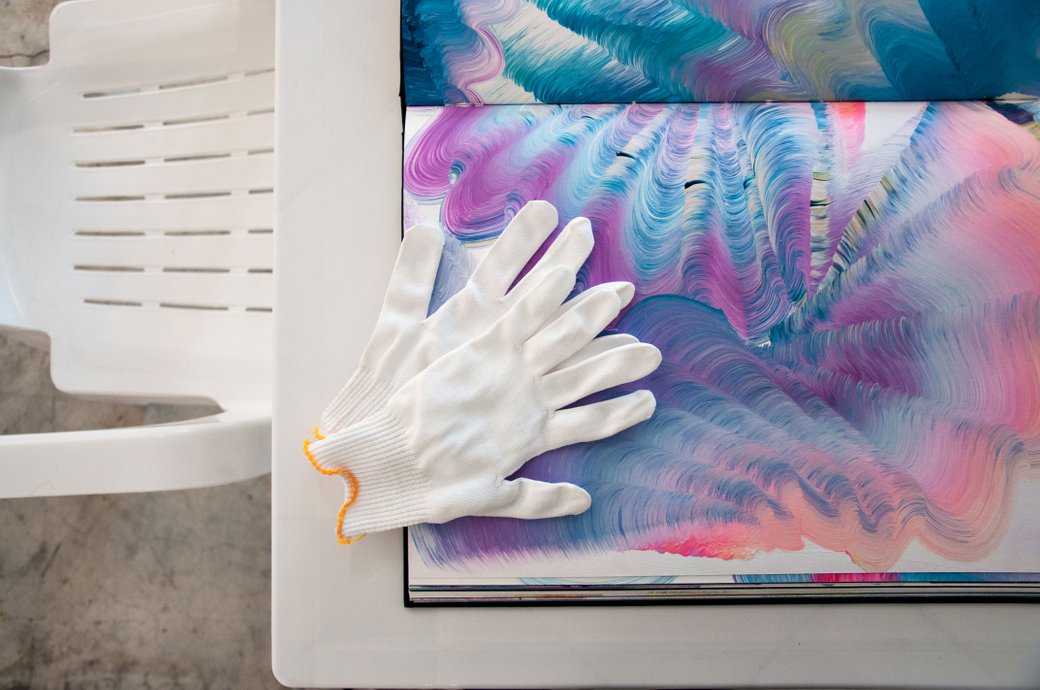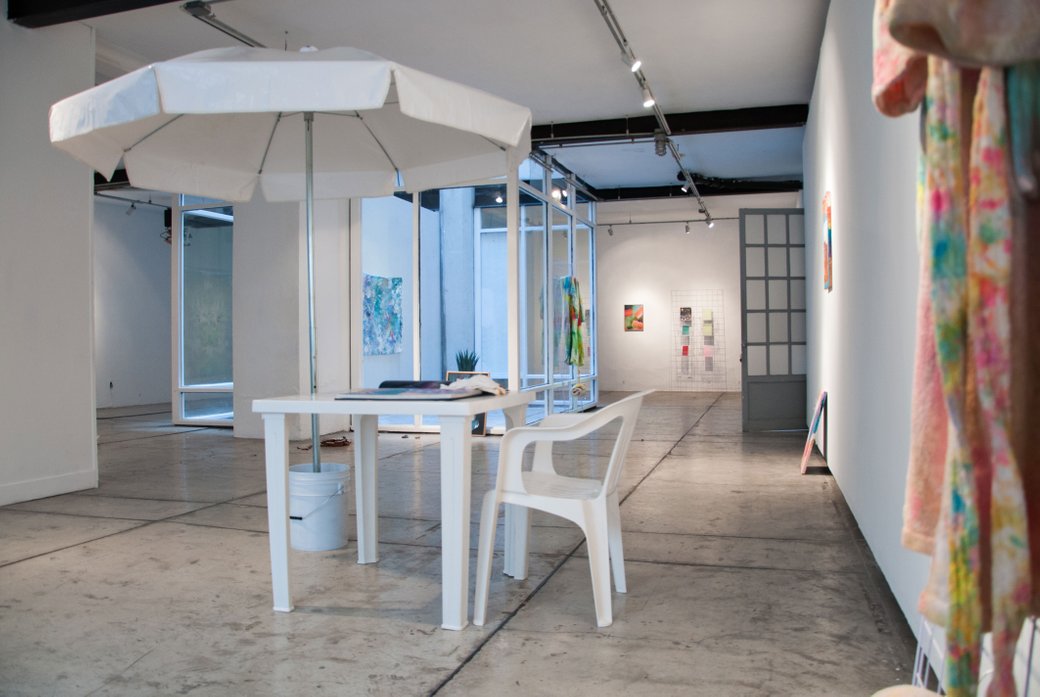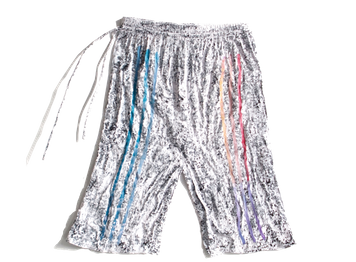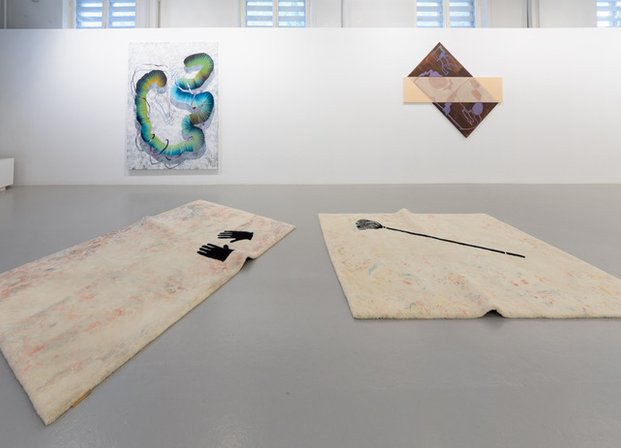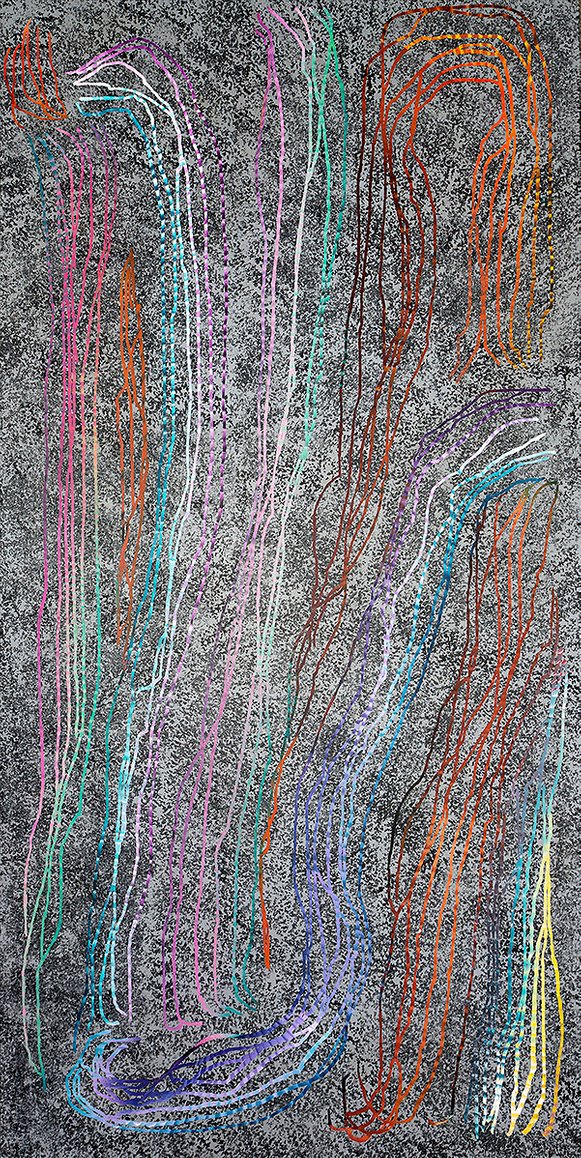Virgin Red Herring
picnic on a painting
Kiasma museum
Helsinki, Finland
24.02.2018
Photo credit Finnish National Gallery/ Petri Virtanen

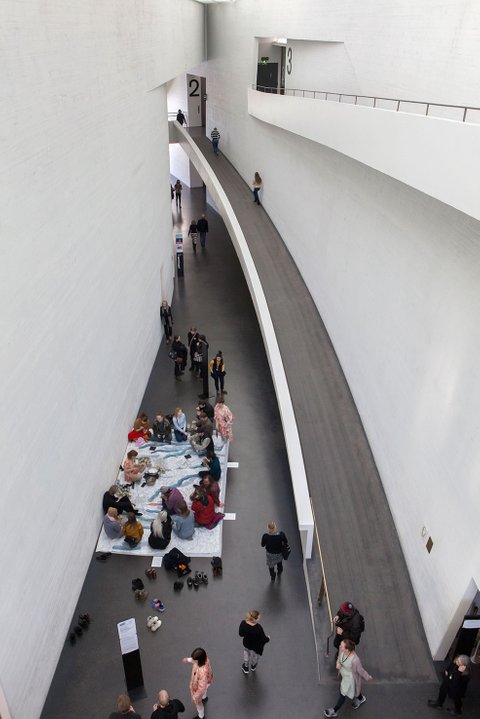
Red Herring engages painting as a stage for human interaction.
Merike Estna’s practice incorporates what she terms "performative paintings" with allusions to the digital, the nostalgic, and a romantic reverence for parts of human existence that are mutating, melting or slipping away. For Performa, she serves artist-crafted cocktails, inviting
the audience to drink and converse atop her paintings. Inspired by Aleksandr Pushkin’s, A Feast in the Time of Plague, Estna plays with
our ideas of Romantic forms of representation and social space.
Photo credit Finnish National Gallery / Petri Virtanen
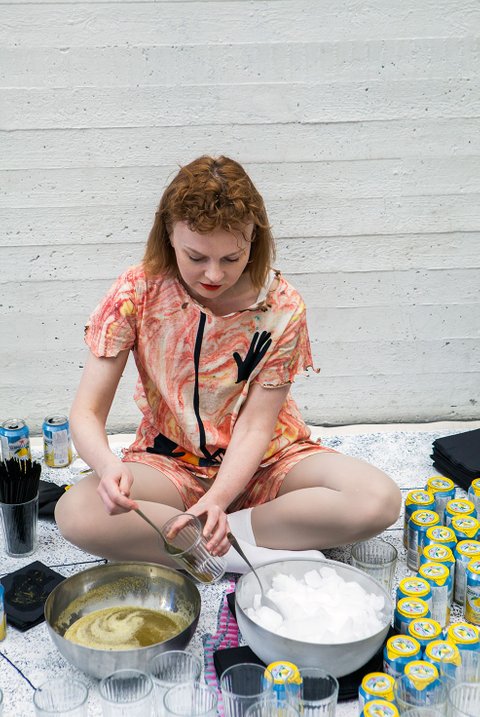
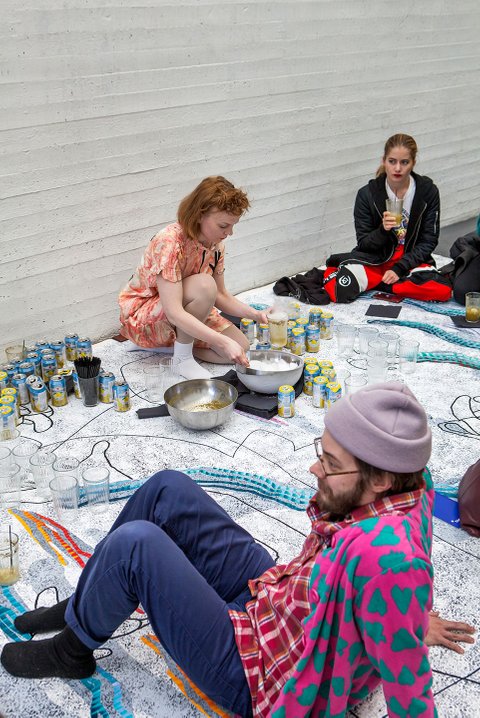
Red Herring
picnic on a painting
PERFORMA 18
AIG New York, US
17.11.2017
photo credit Maria Baranova

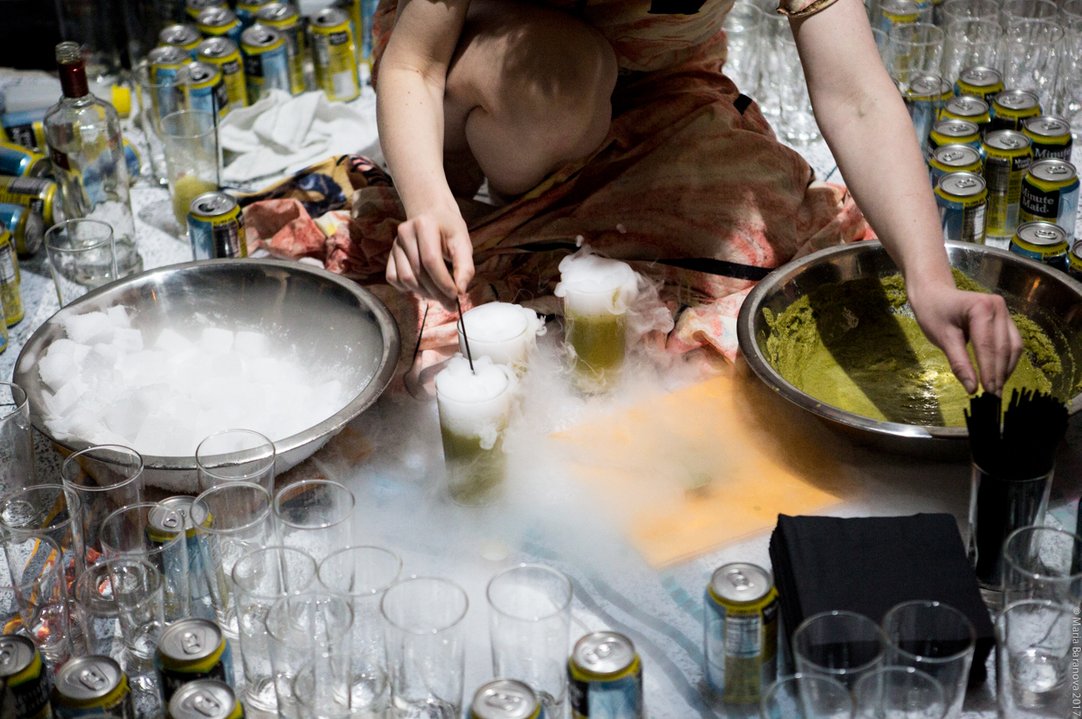
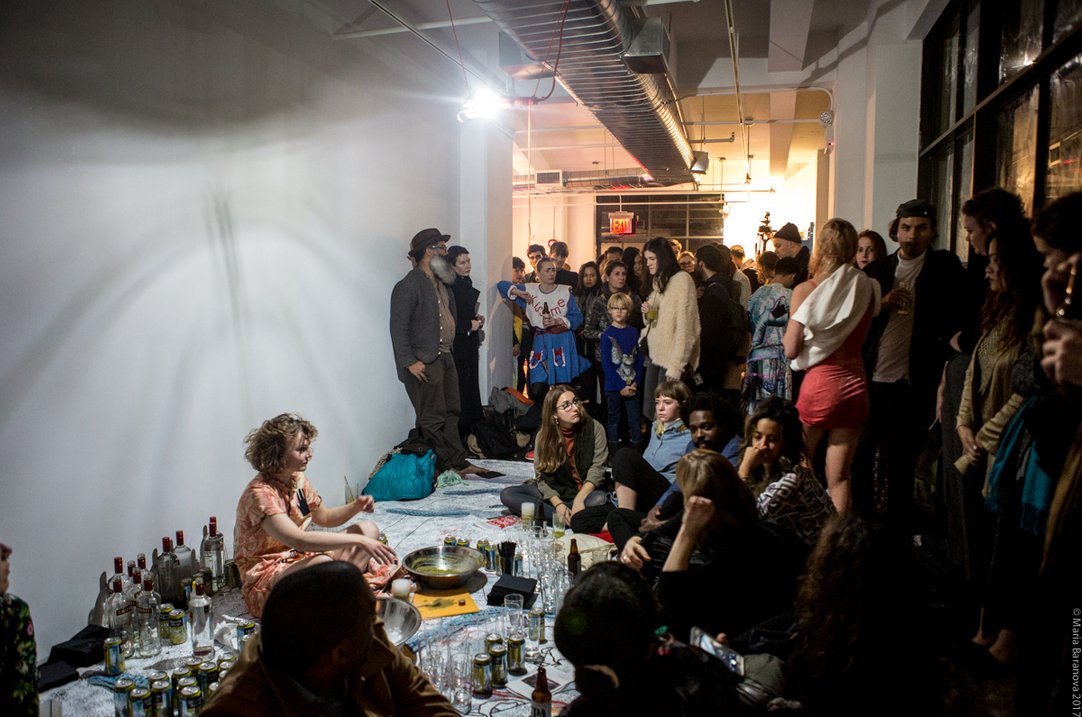
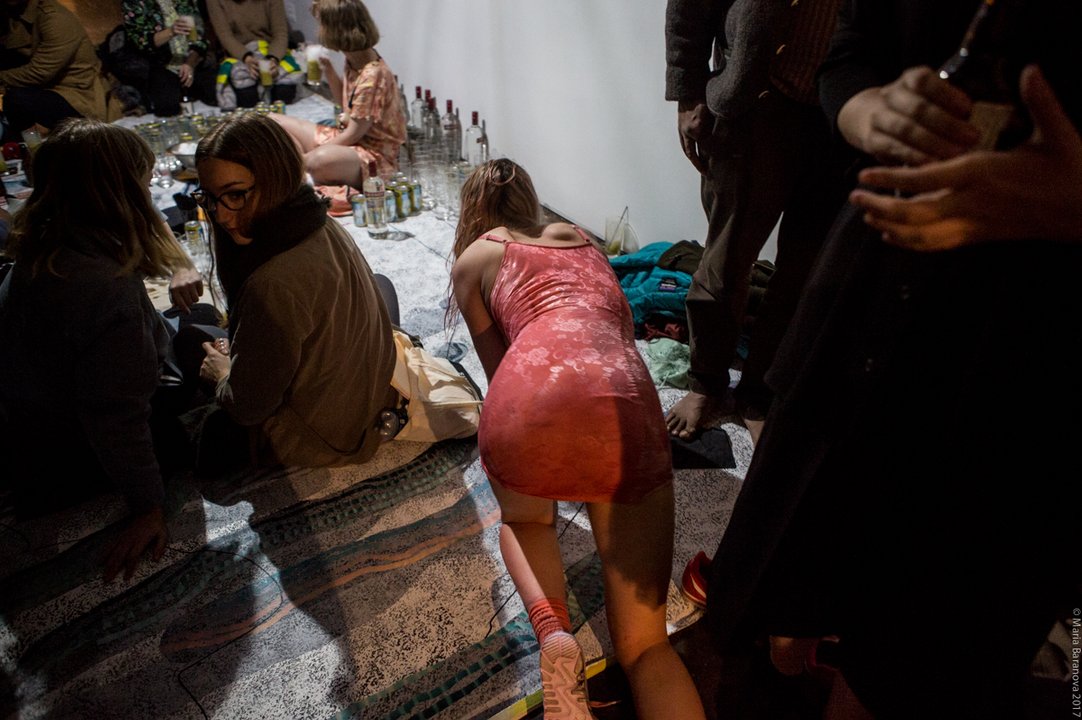
Burning stars
camouflage sets,
clothes to go with the paintings,paintings to go with the clothes
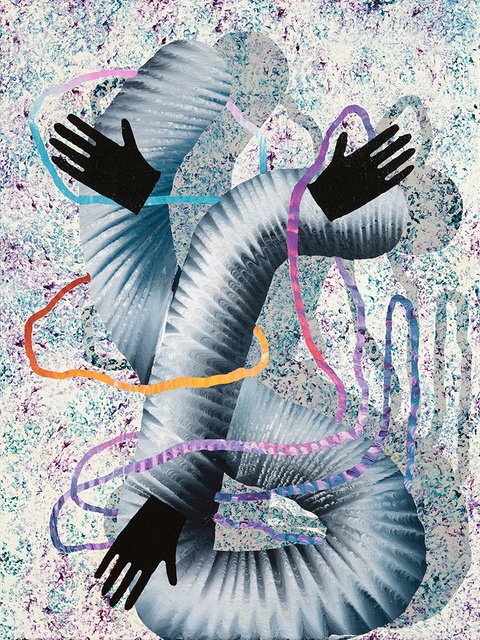
The best rubber gloves for your cleaning needsthe best rubber gloves for clearing weedsthe best rubber gloves for the best rest
acrylic on canvas
60,5 cm x 45,5 cm
2017
photo credit Stanislav Stepaško
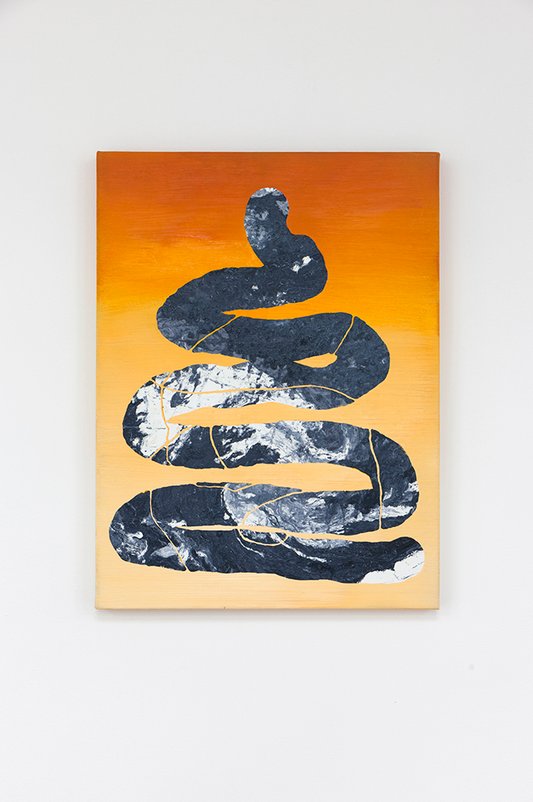
Collapse of the system
oil on canvas
60,5 cm x 45,5 cm
2017
photo credit Stanislav Stepaško
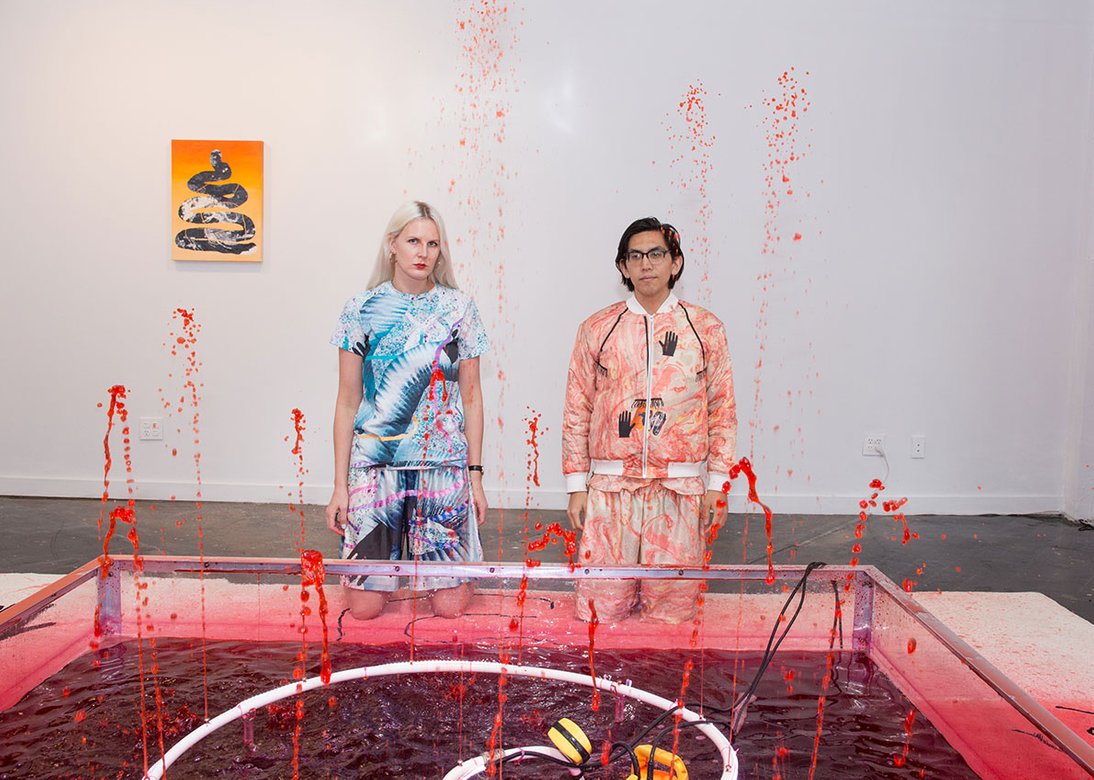
Curator Maria Arusoo and AIG assistant curator Patric Jaojoco wearing Burning stars within the exhibition
Merike Estna and Maria Metsalu
Soft Scrub, Hard Body, Liquid Presence curated by Maria Arusoo
(Center for Contemporary Arts, Estonia) at Art in General New York
United States
Photo credit Marko Krunic

Burning stars
Photo credit Marko Krunic
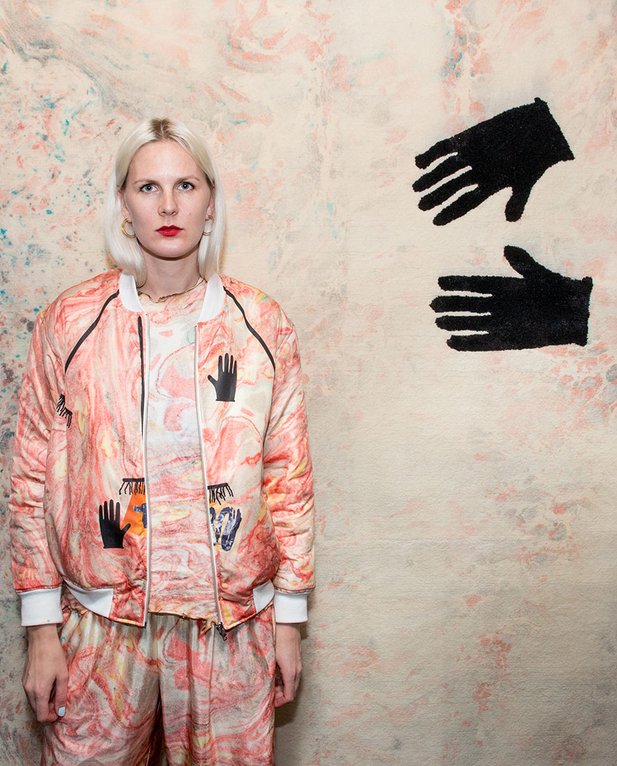
Curator Maria Arusoo wearing Burning stars within
the exhibition
Merike Estna and Maria Metsalu
Soft Scrub, Hard Body, Liquid Presence
curated by Maria Arusoo
(Center for Contemporary Arts, Estonia) at Art in General
New York
United States
Photo credit Marko Krunic
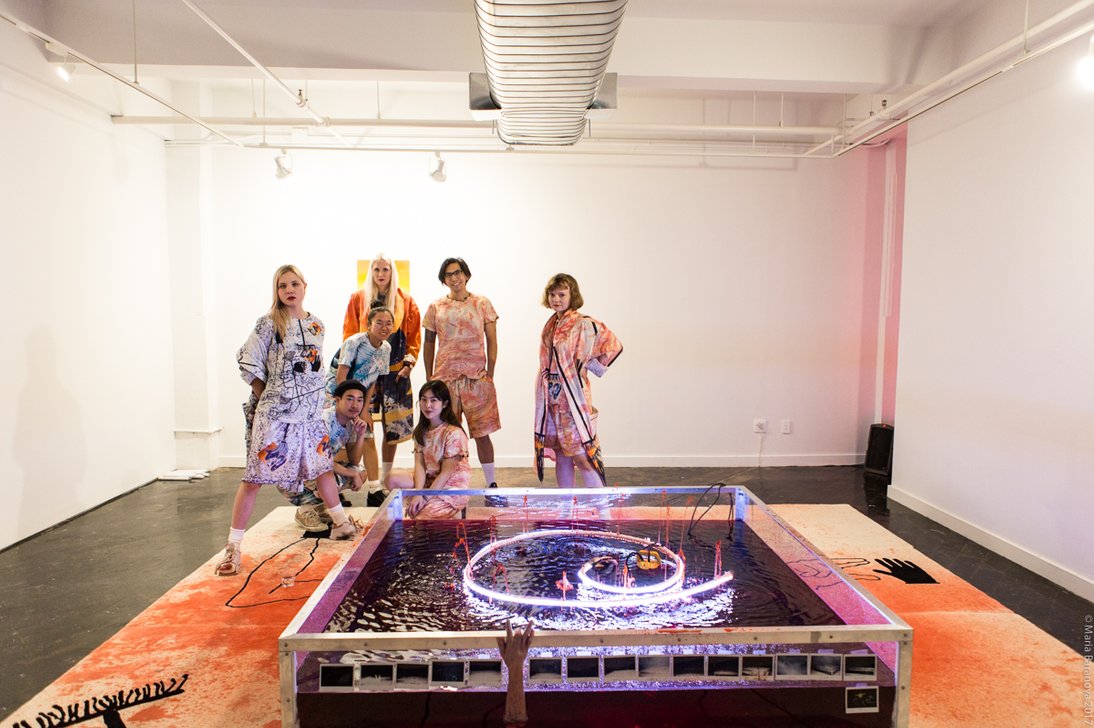
artists, curator and AIG staff wearing Merike Estna special edition Burning Stars commissioned by Center for Contemporary Arts, Estonia produced for and shot within the exhibition Soft Scrub, Hard Body, Liquid Presence curated by Maria Arusoo, Art in General NYC, US, 2017 photo credit Maria Baranova
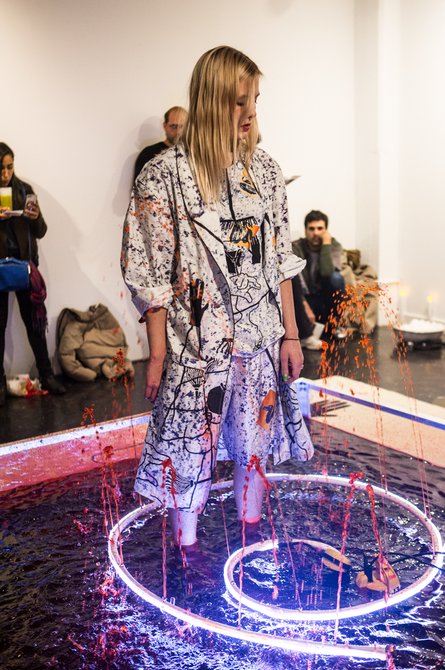
Maria Metsalu wearing Merike Estna special edition Burning Stars during her performance Madmoiselle x, commissioned by Center for Contemporary Arts, Estonia produced for the exhibition Soft Scrub, Hard Body, Liquid Presence curated by Maria Arusoo,
Art in General NYC, 2017
photo credit Maria Baranova

Maria Metsalu wearing Merike Estna special edition Burning Stars during her performance Madmoiselle x, commissioned by Center for Contemporary Arts, Estonia produced for the exhibition Soft Scrub, Hard Body, Liquid Presence curated by Maria Arusoo,
Art in General NYC, 2017
photo credit Maria Baranova
Groundhog Day curated by Andreas Nilsson
SIC space
Helsinki, Finland
08.12.2017 – 21.01.2018
Christian Andersson (SE); Nina Beier (DK); Merike Estna (EE); Ceal Floyer (UK); Luca Frei (CH); Gideonsson/Londré (SE); Kaspars Grosevs (LV); Barbora Kleinhamplová & Tereza Stejskalová (CZ); Jaakko Pallasvuo (FI); Emily Roysdon (US)
Groundhog Day is a 1993 American fantasy-comedy film directed by Harold Ramis, starring Bill Murray, Andie MacDowell, and Chris Elliott. It was written by Ramis and Danny Rubin, based on a story by Rubin. Murray plays Phil Connors, an arrogant Pittsburgh TV weatherman who, during an assignment covering the annual Groundhog Day event in Punxsutawney, Pennsylvania, finds himself caught in a time loop, repeating the same day again and again. After indulging in hedonism and committing suicide numerous times, he begins to re-examine his life and priorities. (Wikipedia)
The exhibition Groundhog Day travels through time and space. It looks at how repetition, recurring patterns, and nostalgia permeate our domestic life and daily routines but also opens up to new perspectives from the near future. The exhibition deals with both activity and inactivity. A performative aspect is emphasized in choreographic and performance based works, but also in the form of site-specific installations and the visitors' own encounter with objects, videos, sound, and paintings. Throughout, the act of repetition is dealt with as something in transition, never entirely repeated in its same form. Is repetition even possible, one might ask? And what is left behind – a vague memory, an uncertainess, a new fact? Or is it just another form of killing time?
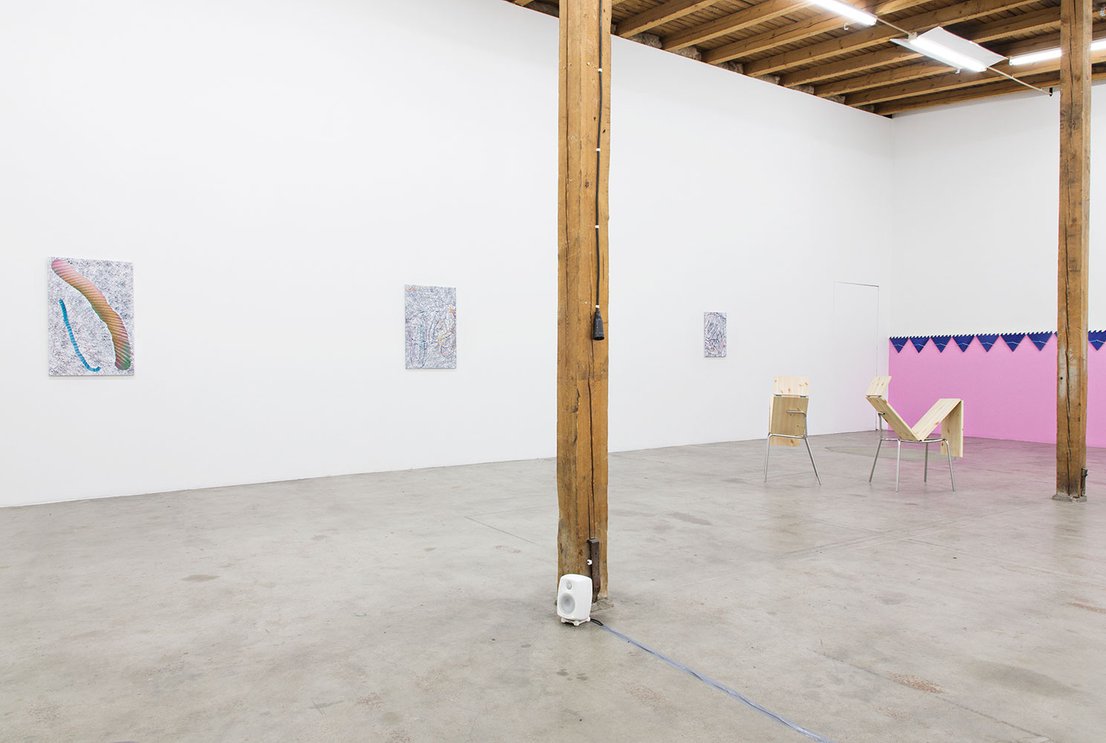
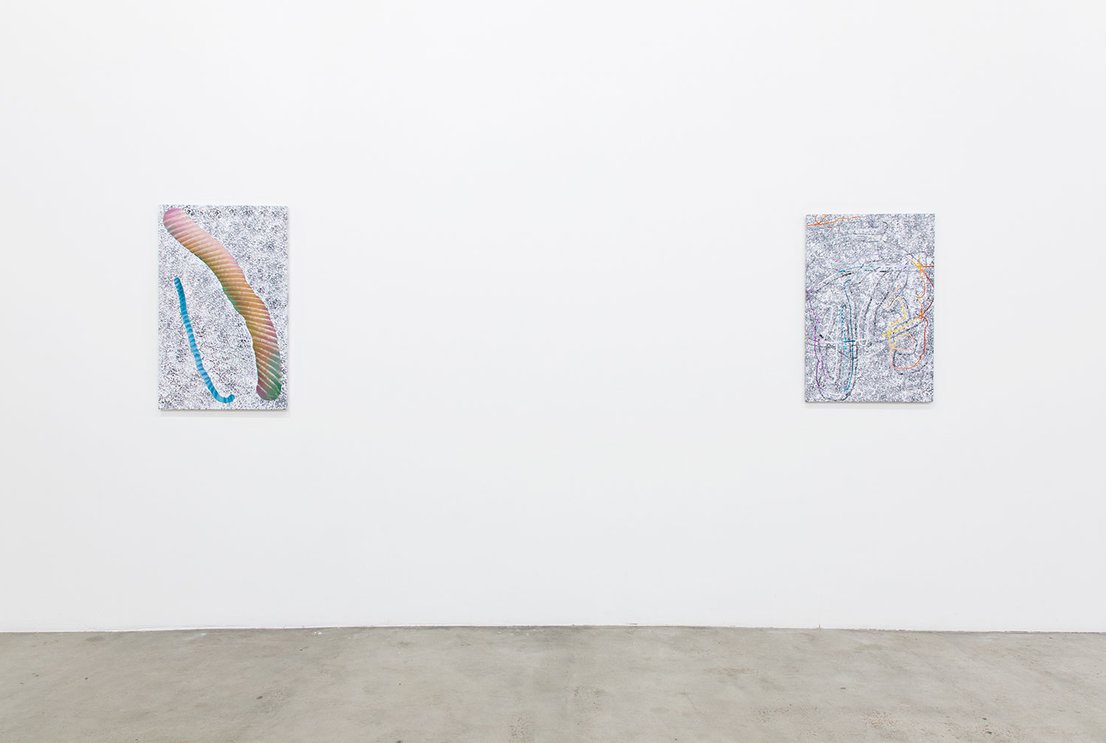
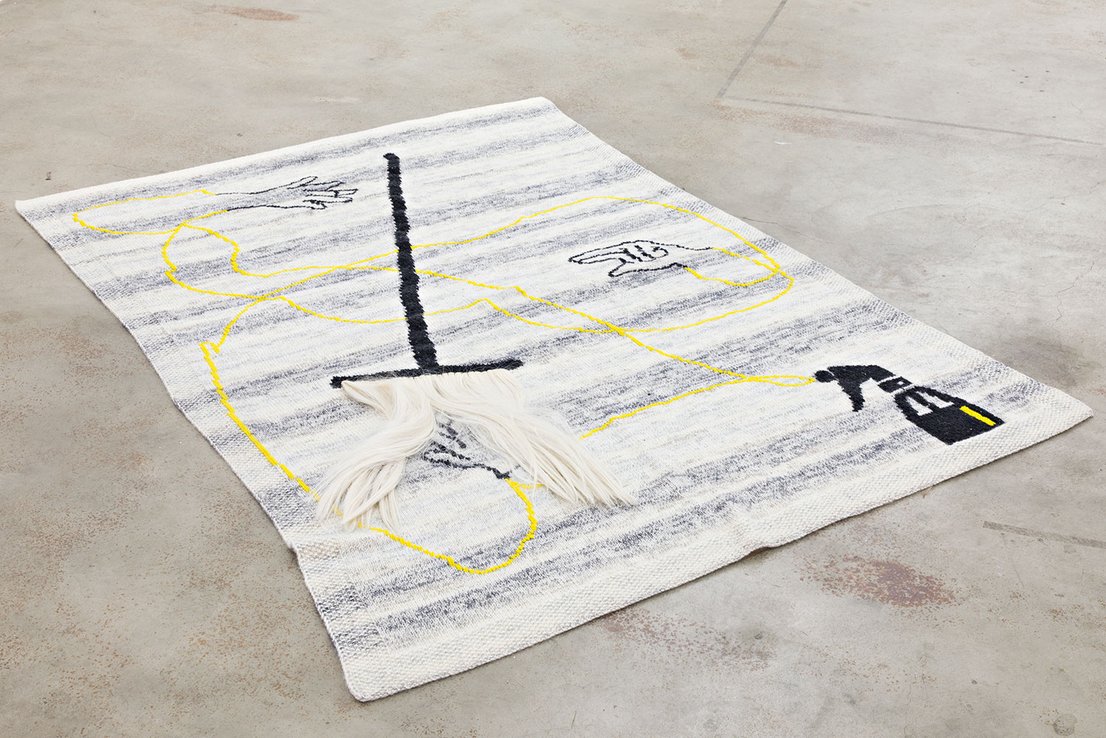
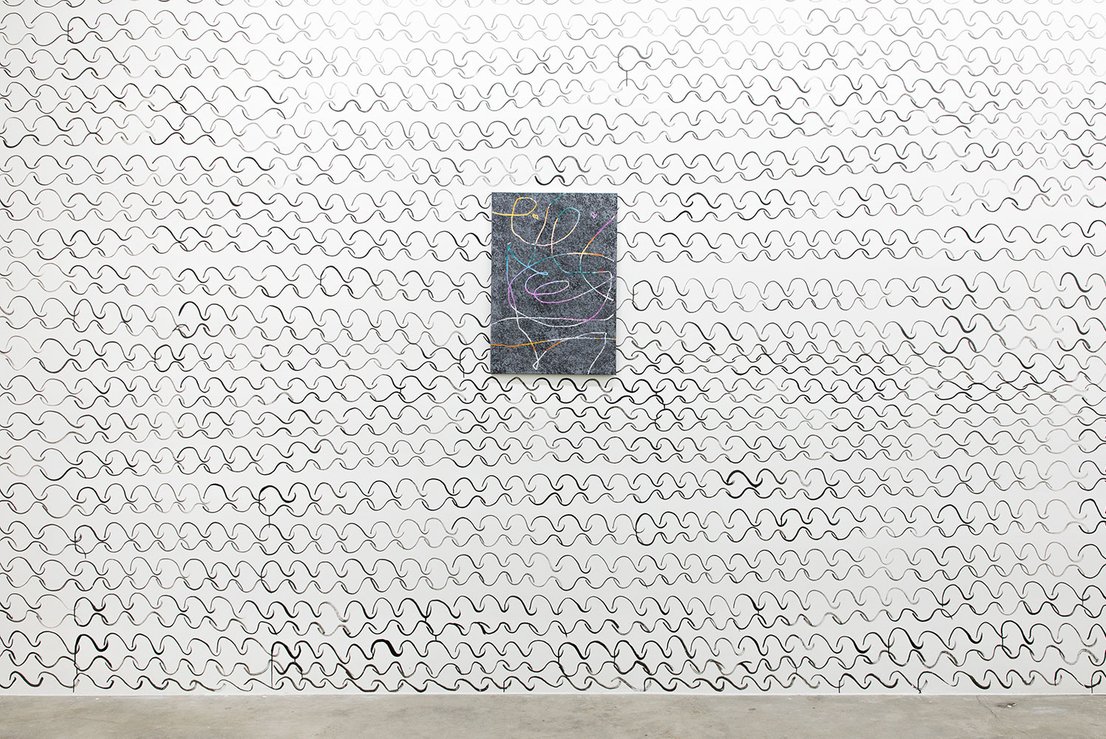
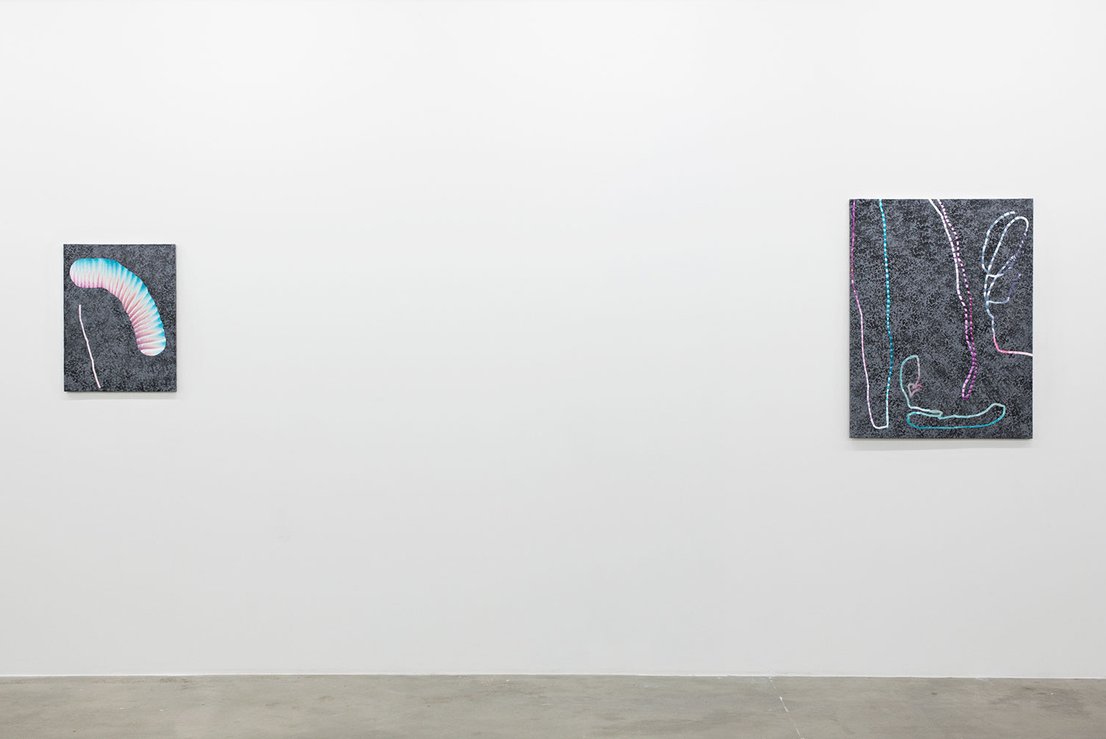
fragments from the shattered toe
solo exhibition
Curated by Thomas Cuckle
Kunstraum
London, UK
29.09 - 25.11.2017
Merike Estna's solo-exhibition at Kunstraum incorporates an intricately painted stage/floor painting which, over the course of the exhibition, hosts a series
of performance events from international dancers, musicians and artist, against a backdrop of Estna’s large-scale curtain painting and other new works.
In her practice Estna seeks for the conceptual integration of painting and daily life, often inscribing the languages, processes and applications of painting onto scenic design and stage-setups. Estna embeds patterns and colour combinations derived from applied arts vocabularies – which haven't traditionally been accepted in the discourse of painting – juxtaposed with what have become familiar motifs of digital communication. Estna's work challenges the masculine territory of painting and questions the strict visual separation between painting and craft discourses. The works are often activated by visitors or gallery staff: as drinks or cakes served, as clothing or hand towels. Her installations become a meeting point for exchange between visitors and the often unstable qualities of painting.
photo credit Dmitri Gerasimov
In one of the earliest online browser games ‘Curve Fever’, multiple players each control a differently coloured ‘curve’ – a single dot that turns into a solid, snaky line
as players command it to either turn left or right. To win the game, you have to continue navigating your curve across the playing field while preventing it from colliding with any of the other lines, creating obstacles for your opponents along the way.
Most likely, this game has been long forgotten, or was never even very widely played. Merike Estna’s solo exhibition ‘fragments from the shattered toe’ at Kunstraum, London, brought it back to mind: not only do her paintings have colourful, thick lines running erratically across large-scale surfaces, she also makes painting itself seem as playful and effortless as a 1990s computer game. But luckily for us, Estna’s work is not presented on flat screens, but enwraps the viewer from different sides of the room with varying materials.
‘damage was reparable’ (2017) is painted on a thick piece of unstretched canvas hanging across the wall like a curtain. Here, Estna has painted a mop opposite its bucket – due to their black outlines, these objects seem to be hovering on the pastel surface of the painting, ready for action. Estna’s labyrinthine lines connect these two familiar household objects to each other, tracing a myriad of possibilities like an algorithm for snakes and ladders.The central element of the exhibition, however,
is ‘toe, toe, toe, go, go, go’ (2017), a large plywood stage covered entirely by Estna’s painting, that welcomes the audience, as well as performers, to stand and walk
on top of it. Here, emoji-like hand gestures gently command the user into different directions, guided by zigzag lines that resemble jelly worms. ‘fragments from the shattered toe’ (2017), the work which lends the exhibition its title, quite literally embraces the viewer: it is a wearable rug, hanging from a trapeze, and gorgeously painted with a pink and turquoise marble pattern. Black hands (or gloves?) are woven into the fabric, but look graphically designed – a further example of Estna’s
clever interweaving of digital techniques with traditional materials.
Since Curve Fever was released in 1995, digital interfaces are increasingly competing for our attention at all times. They allow us to consume contemporary art alongside Kermit memes, play Candy Crush while receiving e-flux newsletters, and to express genuine affection using virtual heart emojis. As the boundaries between high and low, mundane and sublime, and handmade and coded thus become increasingly blurry, Estna’s work cleverly exploits the seductiveness of digital surfaces and designs by mimicking them through painting and craft techniques. ‘fragments from the shattered toe’ turns painting into an ever-shifting, dizzying game, and invites us to come
out and play.
Brenda Guesnet
Photo credit Benjamin McDonnell
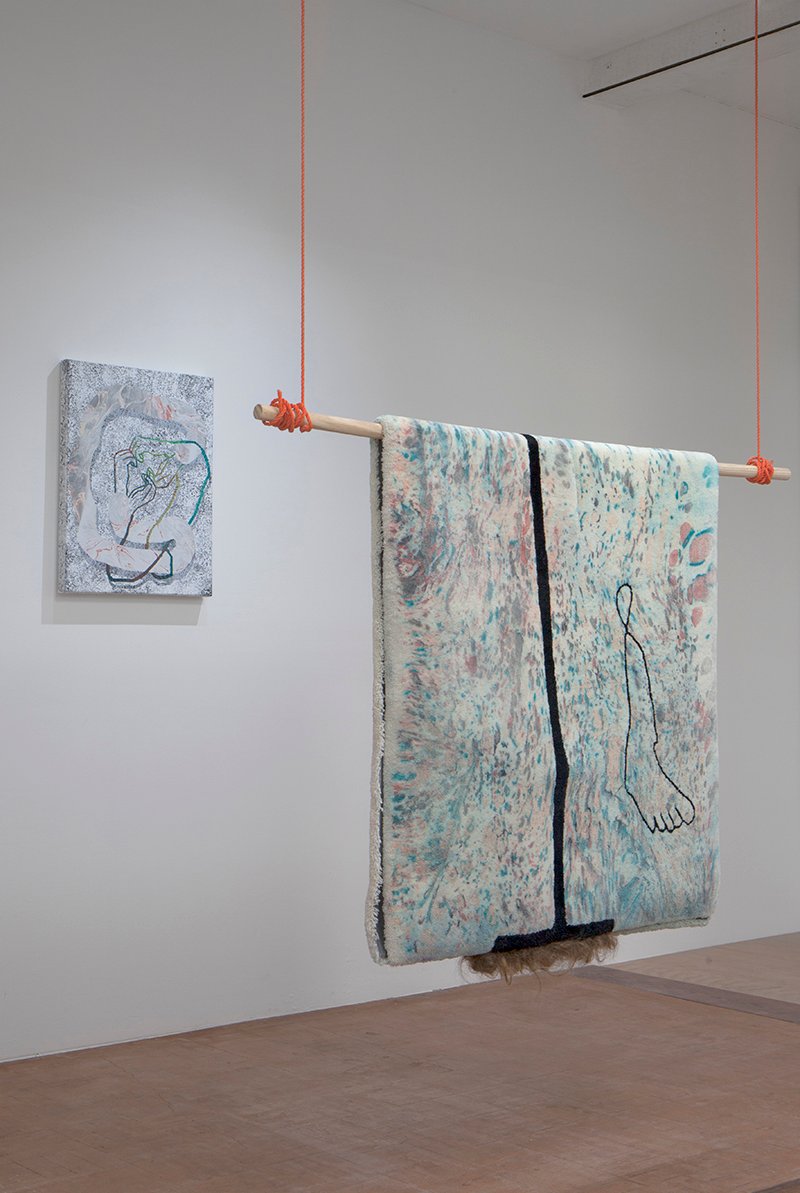

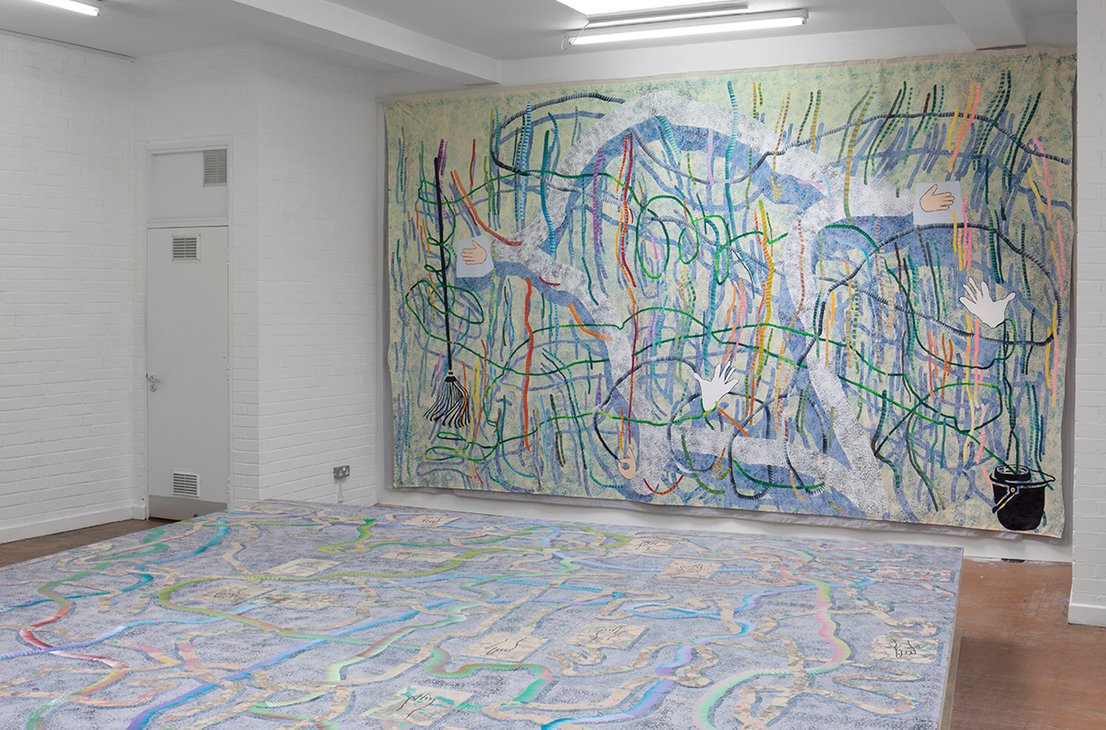
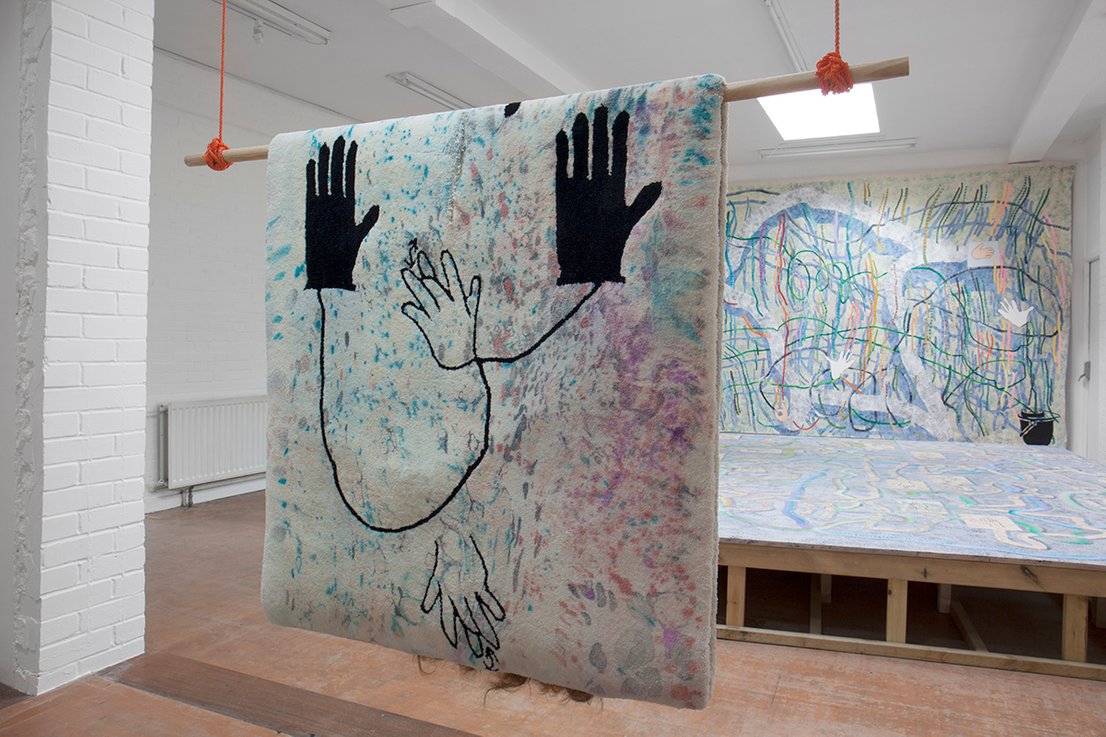
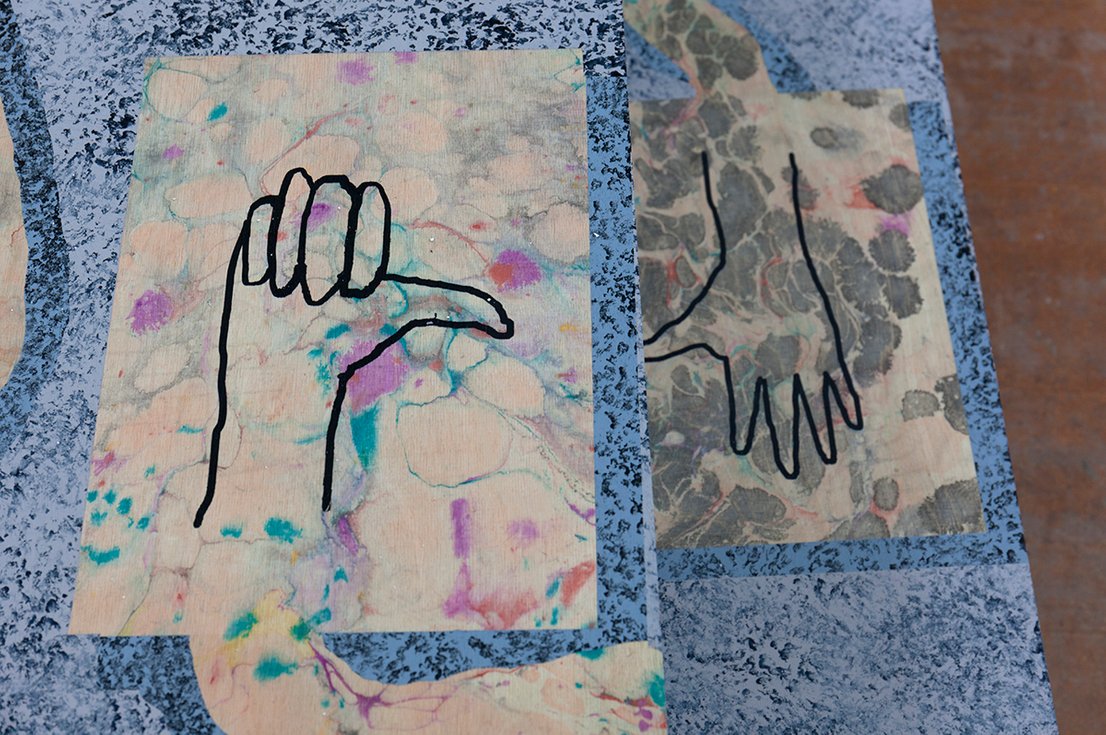
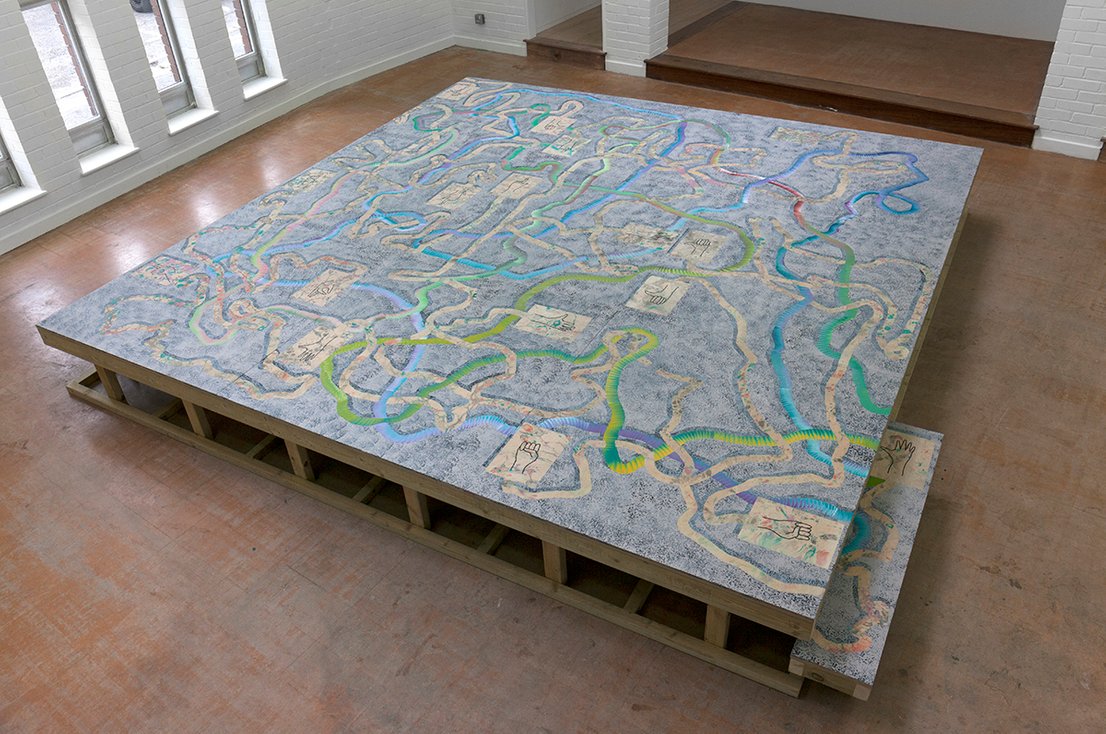
"The seed can be initialized randomly II"
Temnikova & Kasela Gallery Tallinn, Estonia
May 18th - Jun 16th
Jun 17th - Aug 18th by appointment only
Ana Cardoso (1978) and Merike Estna (1980) are both painters who have come together at two different geographic and temporal points to explore the medium of painting, traditional crafts and a woman’s place in the
art world.
The first series of this exhibition “The Seed Can Be Initialized Randomly” took place in Porto, Portugal in 2016 where the two artists explored traditional Portuguese tiles asa medium for painting. The second installment of the exhibition (Tallinn 2017) further explores what is often considered a craft material or folk art – with the artists working
on paintings reinterpreted as traditionally crafted rugs.
The artists push against the notion of paintings as precious objects, and take a feminist approach to the hierarchy between crafts and applied arts versus fine arts. Women’s creative works have traditionally been less valued than the works of men. Painting was considered a masculine field, and crafts were considered women’s work. Crafts and handiwork were
a task that women could work on between their other domestic duties. This is signified in the works by the hands (handicraft) and the cleansing element of domestic tools such as mops and brooms. Their works probe the boundaries what makes paintings legitimate and acceptable, and if feminine aspects and forms of creative expression are yet accepted in fine arts.
Ana Cardoso works in abstract painting and utilizes anthropometric structures, interwoven with images and materials, which enable multi-dimensional readings. Ana’s “Recto-Verso (Fold)” and “Sender Over Quota III” play with the tromp-l'oeil of a 'fold' in the canvas. The illusion of a fold references the material reality in the front and the verso (back) of a surface, which is an important characteristic of process based painting. “Sender Over Quota III” samples and alters a floral pattern, appropriated from Daan Van Golden, who had appropriated it from Japanese wrapping paper. The geometric pattern is a subtle nod to Anni Albers, her structures and gender non-specific roles.
Merike Estna’s work samples symbols like a DJ samples music, with reoccurring elements such as: David’s foot, Emojis, sign language hands, brush strokes as ready made and the liquid to solid form of rocks in marble and replica stone. Estna’s works function as a screen showing the many layers of history of the canvas through holes on the top layer of the painting. Parts of the background of the paintings peek through from the top layers – the exposed foundations denote memory, wanderlust
and a romanticism of the canvas.
Ana Cardoso and Merike Estna are linked not just by their boundary pushing paintings – but also in the performative process and time-based aspects of their works. Conceptually their artworks echo contemporary social concerns with allusions to the digital, the nostalgic and a romantic reverence for parts of human existence that are mutating, melting and slipping away.
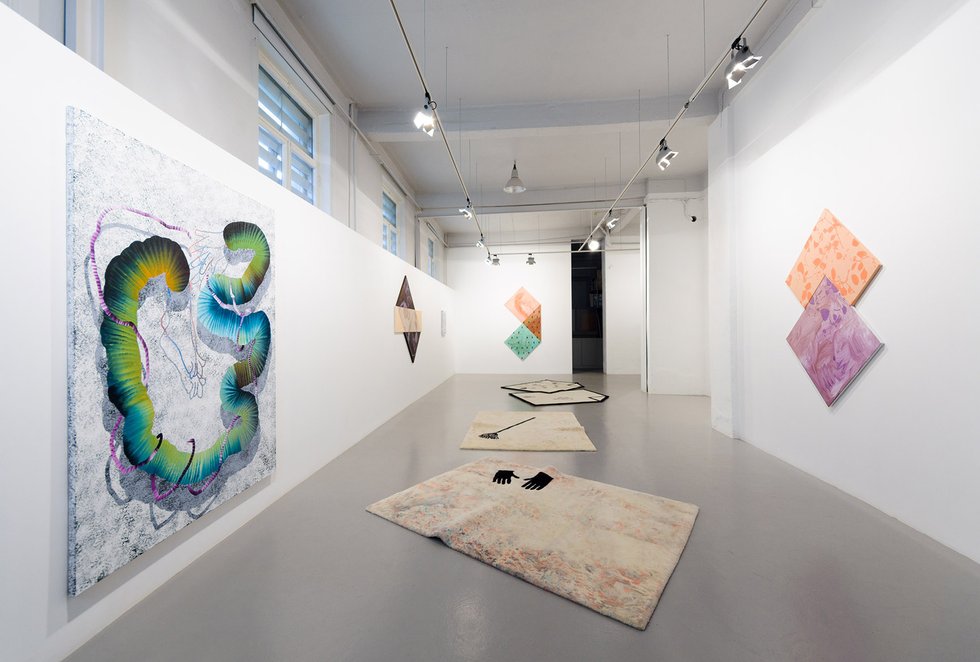
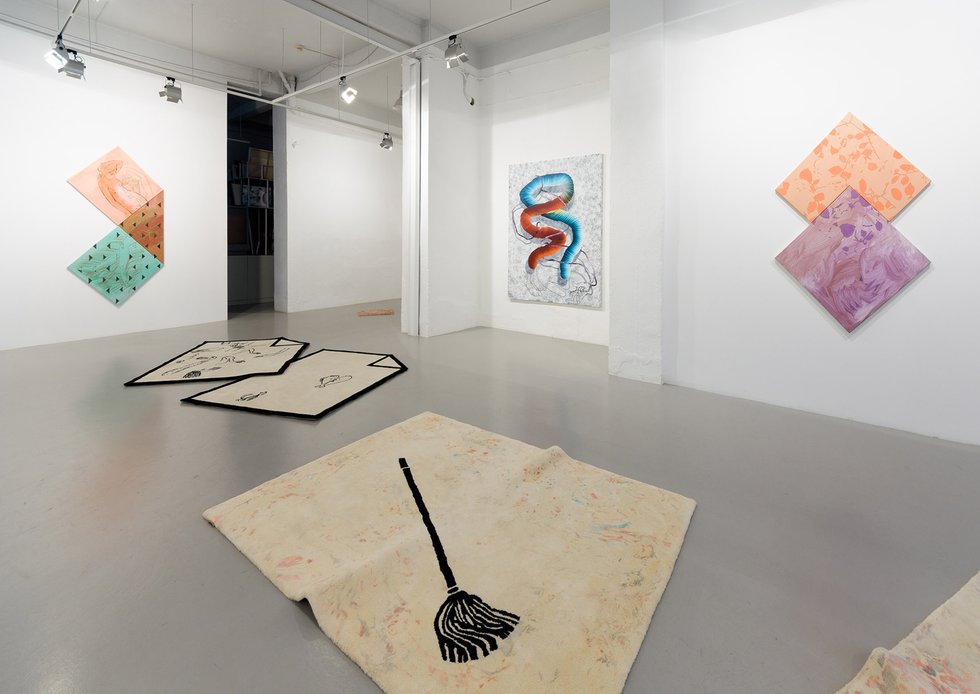
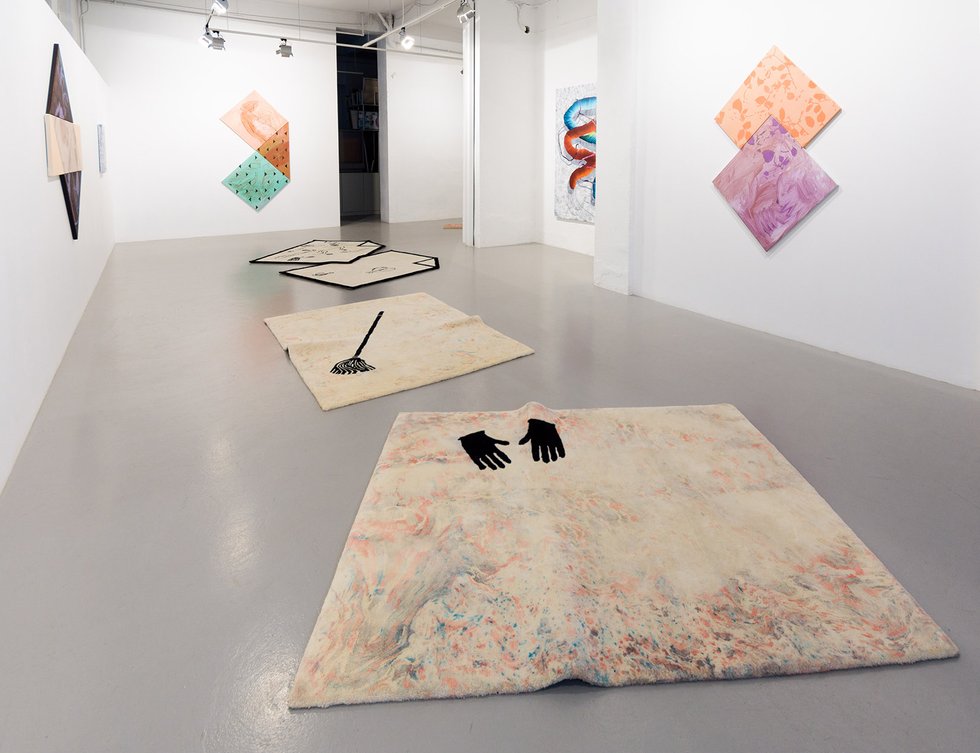

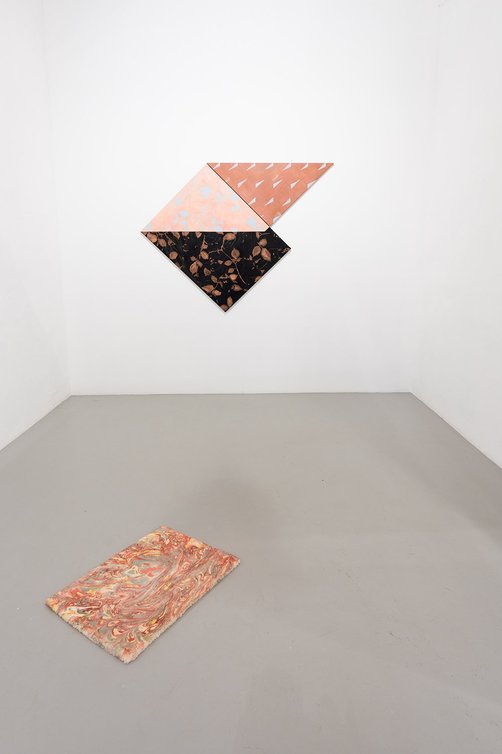
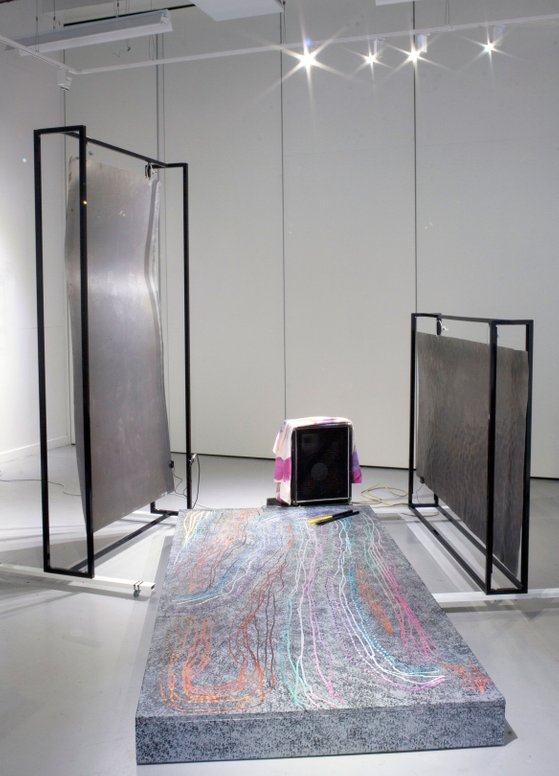
On Becoming Fluid
17/03/2017 - 06/04/2017
Merike Estna + Keef Winter
Hardwick Gallery, University of Gloucestershire,
Hardwick Campus, St Paul's Road,
Cheltenham,
GL50 4BS
Link:http://hardwickgallery.org/exhibition/on-becoming-fluid/
Merike Estna + Keef Winter ‘On Becoming Fluid’ is a series of new works installed site-specifically in Hardwick Gallery. The exhibition consists of two expanded practices intertwining sculpture and painting.Estna’s works are vast painted canvasses that run through the space like run-away curtains. Estna’s work becomes at once a painting, a sculptural object and a spatial treatment. This manifestation of her research into the acts of painting and visual/virtual language expresses the possibilities of experiencing and looking playfully at things. Both through the aesthetic presentation and through the visitor’s experience a sense of immersion is generated at different scales.Winter’s works are a series of sculptural apparatus that also function as noise-making instruments to be played as an ensemble. Beginning from his ‘Handyman Aesthetic’ method of production, Winter welds and powder-coats steel bar and sheet to create a range of abstracted trolleys, surfaces and devices.On the opening night there will be a series of performances by Winter and Estna and invited guests. Merike will mix her signature ‘cocktails as paintings’ to be drunk and never seen again. Winter’s performance uses his sculptural apparatus to create a cacophony of noise via sheet steel, hammering, contact microphones and a sound system alongside Hardwick Gallery curator Sarah Bowden.Also joining Estna and Winter are acclaimed musicians Chris Cundy and Bobby Barry & Ian Mikyska who will be responding to the exhibition with improvised music sets on the 17th March from 6pm – 8pm.
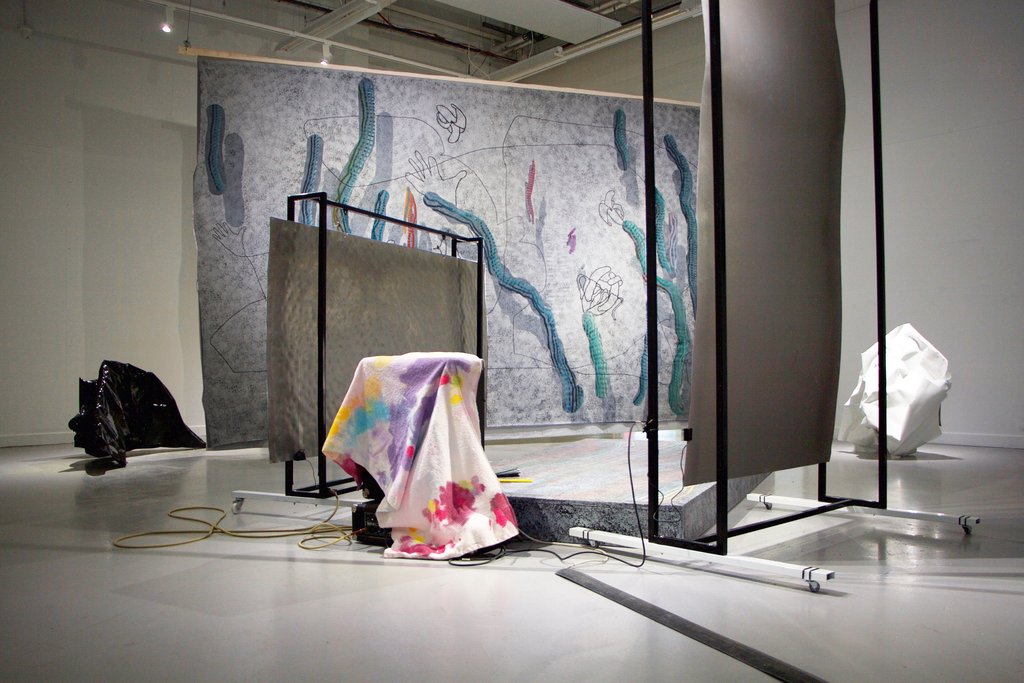
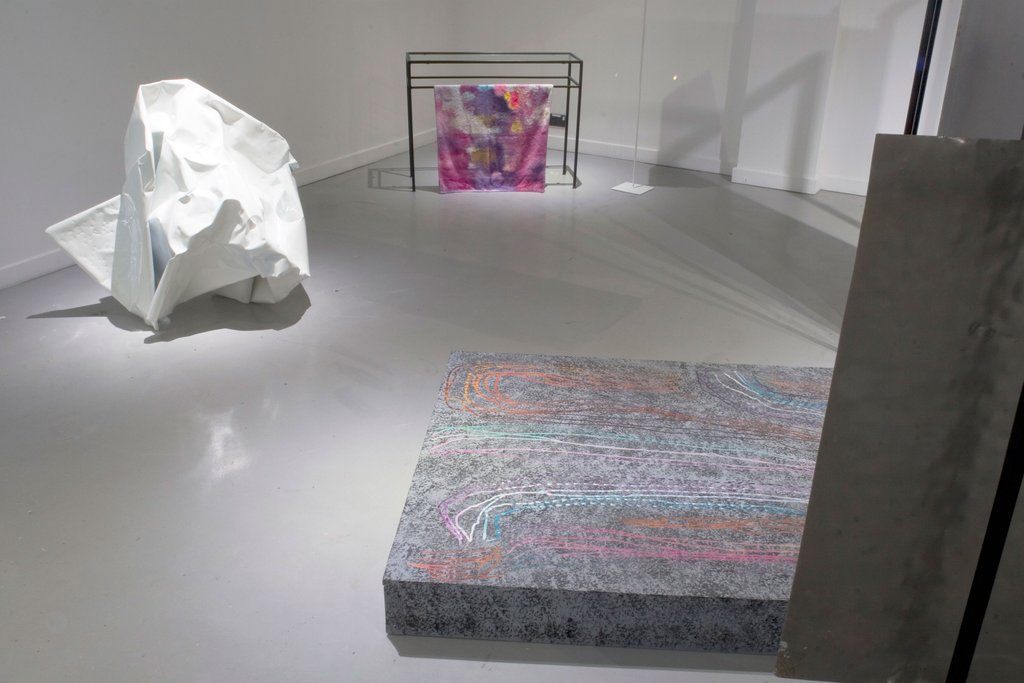
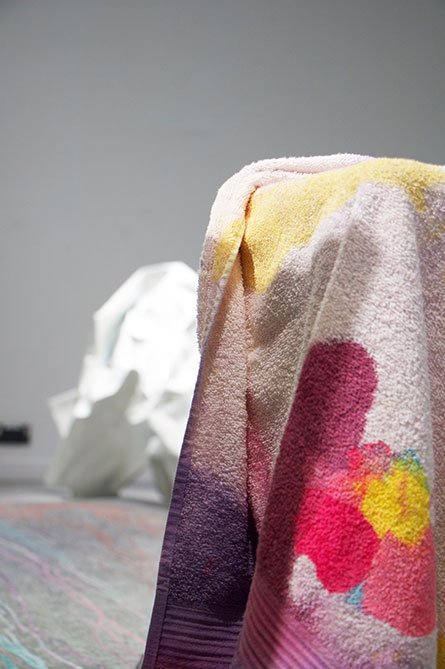
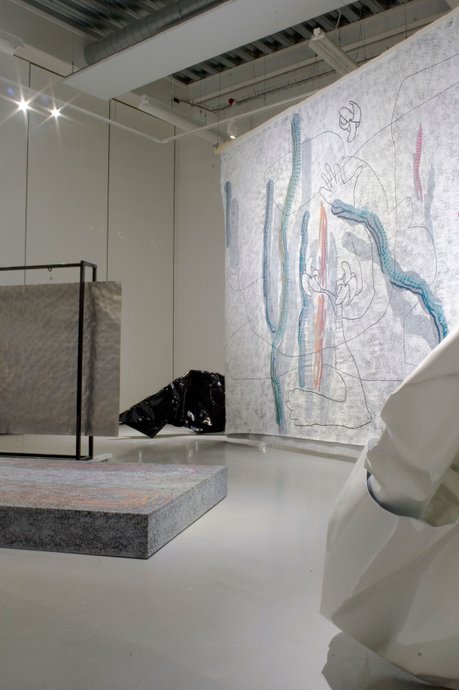

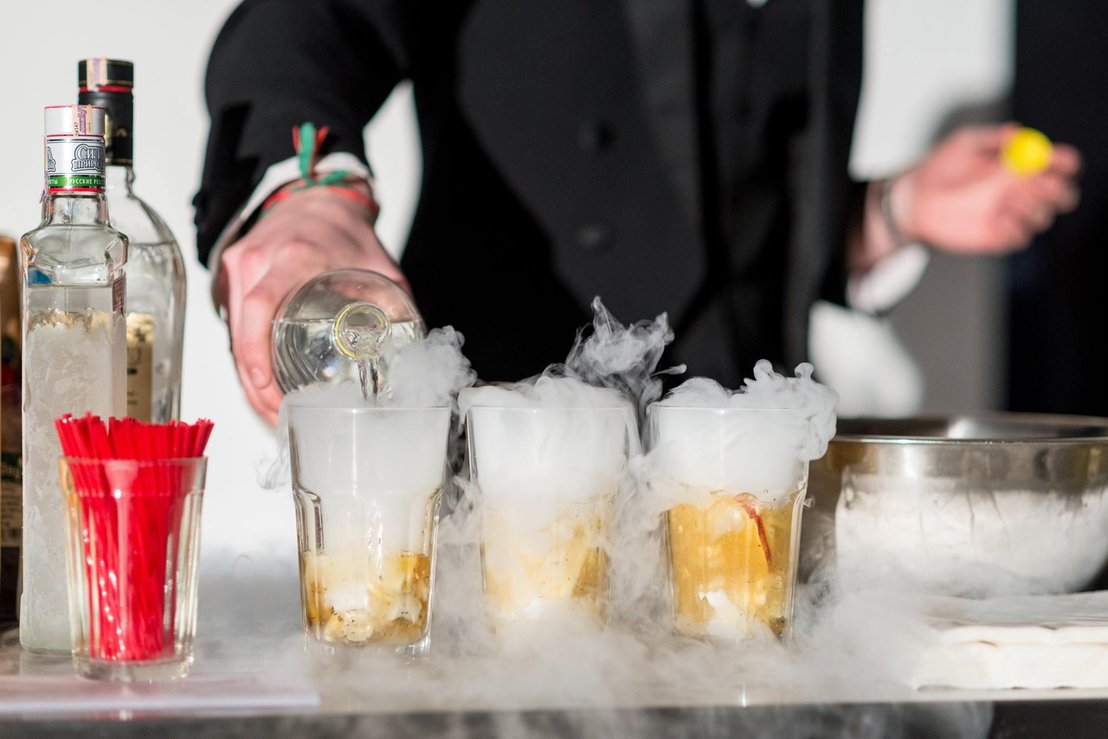
Smoke and Mirrors
Merike Estna / Jozs Bitelli / Andrea Zucchini
30/01/17
RUPERT, Vilnius, Lithuania
Rupert residents invite you to an informal presentation of what they have been working on during their stay.

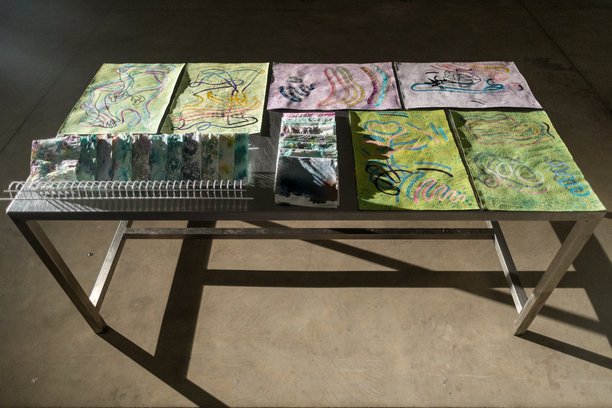

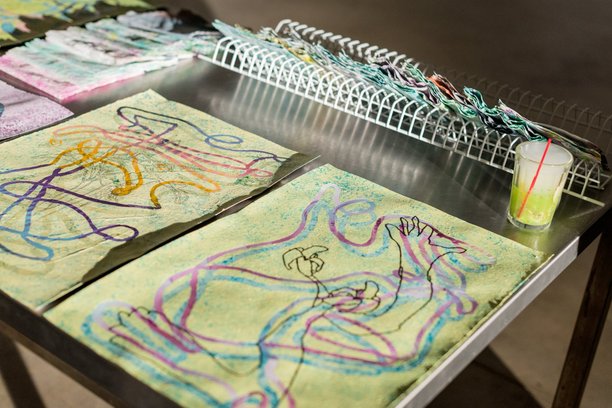
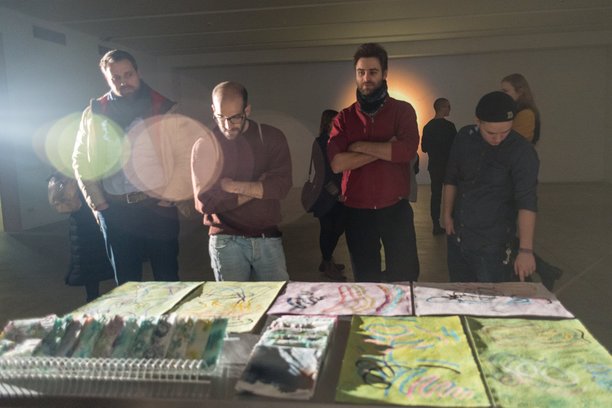
works: Merike Estna
Series of paintings
“Post Nostalgic Dining story”
acrylic on paper and on serviettes, liquids to be consumed, dry ice.
Wed 4 Jan
-Hei
-Labas
-Hey, if you’re still out, could you grab some AA batteries plss x
-OK will check if this place has some hopefully
-Got it
-Ahh u
-Hey, you still up for going? I’m just waking up
-Just sent you the fb link as well
Thu 5 Jan
-Kk so my key doesn’t work in the door, maybe lock your room tonight & we can ask about it tomorrow, nice dining with u
Sat 7 Jan
-Hey good morning
-Do you wanna go to see the shows at CAC around 1pm?
-As I’m thinking I’m not sure I could come back to town later as feeling like getting ill:(
-Aww nooo
-Don't get ill
-Yeah id like to but I just woke up, I've got a bad case of the sentimentals, and indigestion too.
Mon 9 Jan
-Hope you made it! Gd luck with the hanover xo
-Thanks, just landed, luckily finally managed to get a cab obviously no ubers at 4am, a bit of a panic but made it:) have a good few days, xx
-Phewww, glad it didn't spin out of orbit cos of snow
-Haha yea kind of exiting
-The ice on the lake isn’t moving anymore-Oo wow! So it’s freezing:) fab!
-I hope we can walk on it soon, n the sunmakers will have an extra road!
-Just made a really bland and awful meal!
-No way! I can’t believe you
Mon 23 Jan
-Hey how’re you? Are you planning to go into town? Or wanna make dinner around 7? fyi The reading group was so nice & I'm just speaking to some people about singing in the performance.. if it happens...
Sun 22 Jan
-I can only smell dog! Bigly
-Haha, probs just smoke and mirrors
And just a few brushstrokes away just a few lines of memories just a single drop of paint, 2016.
painting as a stage, acrylic on MDF board
122 x 244 x 20 cm
photo: Matthias Bildstein
Courtesy Georg Kargl Fine Arts, Vienna
WINTER IS COMING
(Homage to the Future)
09/09/2016 - 23/12/2016
Andreas Angelidakis | Merike Estna | Michael Gumhold | Joey Holder | Kolbeinn Hugi | Kris Lemsalu | Jaakko Pallasvuo | Natasha Papadopoulou | Angelo Plessas | Agnieszka Polska | Triin Tamm
curated by Maria Arusoo
Georg Kargl Fine Arts Schleifmühlgasse 5A-1040 Vienna
“After the Summer of the Greek humiliation, camethe Autumn of rejected migration, then the Winterof European disintegration, before at last the Springof Donald Trump.”* Franco Bifo Berardi
We are living in a dystopian present in which things are now so fetid that it is no longer possible to look away from the current crises and growth in xenophobia. The great and empowering promise of ‘the future’ is dissolving, and we are being forced to alter our belief systems repeatedly within condensed frames of time.In our neo-liberal society — where with each step you take you are forced into individualism and self-management, and are overtaken by the contemporary drive for acceleration — we are experiencing a generational loss of knowledge about what it means to be part of a community with shared goals.In the exhibition WINTER IS COMING (Homage to the Future) at Georg Kargl Fine Arts, loss is a recurring theme, and forms the basis for a dialogue around subjects including the collapse of systems, nomadic experiences, myths, belonging and meaning. A number of the participating artists work in search of alternative subsystems and meta-languages, where Net, bio-technology or ancient myths are used as mediums through which to explore humankind's place in the world. The works playing with ancient myths and current meltdowns create a psychogeography of bio-futuristic and techno-animist settings, partly observing situations in the distance and partly attempting to reimagine ways of reconnecting with each other—a search for a meaningful ecosystem.The exhibition is presented as a rhizomatic platform whose range covers a number of territorial oppositions: the expanded environment of the internet and the offline sphere; new technologies and the concerns of ancient humans; political awareness and escape; dystopia and utopia. The exhibition is intended as a complex entity, and brings these works together in aim of expanding thought on the limits of togetherness, connectivity and the potentials for adopting invented communities.
Text:Maria Arusoo (*1983 in Tallinn) is an artistcuratorcurrently working as the Directorof the Center for Contemporary Arts Estoniaand the Commissioner of the EstonianPavilion at Venice Biennial.
16th International Vilnius Painting Triennial ‘Nomadic Images’
24/11/2016 - 31/12/2016
Artists participating in the exhibition:
Heikkilä (FI), Andris Vītoliņš (LV), Bronius Gražys (LT), David Schnell (DE), Eberhard Havekost (DE), Ewa Juszkiewicz (PL), Gintaras Palemonas Janonis (LT), Jan Poupě (CZ), Jens Fänge (SE), Jolanta Kyzikaitė (LT), Jonas Gasiūnas (LT), Jonas Jurcikas (LT), Kristaps Ģelzis (LV), Kristi Kongi (EE), Konstantinas Gaitanži (LT), Laisvydė Šalčiūtė (LT), Linas Jusionis (LT), Markus Åkesson (SE), Merike Estna (EE), Mihkel Ilus (EE), Mircea Suciu (RO), Mykola Belous (UA), Ragna Bley (NO), Rafał Bujnowski (PL), Ramūnas Čeponis (LT), Tomek Baran (PL), Žygimantas Augustinas (LT).
Curated by Linas Liandzbergis
Museum of Applied Art and Design in Vilnius (Arsenalo 3A), Lithunia.

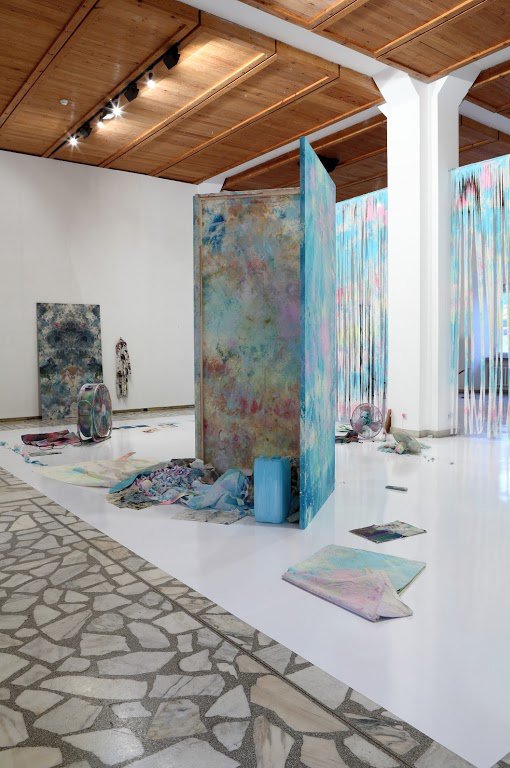
.jpg?etag=W%2F%225c4c9-58c40b6a%22&sourceContentType=image%2Fjpeg&ignoreAspectRatio&resize=395%2B263&extract=0%2B0%2B394%2B263&quality=85)
The idea of the 16th International Vilnius Painting Triennial ‘Nomadic Images’ is based on a strategy of wandering in different territories, without priorities or a uniform plan, observing, comparing, evaluating, but not conquering. When travelling, combinations of seen objects and experiences form in an accidental and unregulated order, and bring back forgotten memories, which summon new combinations. This provision of the organisers is closely related to the wandering world vision articulated by the contemporary thinkers Gilles Deleuze and Félix Guattari, in which reality
is constantly changing, and is described using notions of the rhizome and the labyrinth. Nomadic space is understood as a decentralised expansion of territory, an arena for unprogrammed processes, accidents, spontaneity and incompleteness. In adapting these ideas to the field of contemporary painting, we can understand the forms of expression as a potential infinity that can take various configurations, grow freely, and develop in any direction.
A conceptual approach towards the triennial’s content allows us to avoid a horizontal view of the field of painting, like an overview, and gives it an intellectual dynamic. Innovation in painting, and changes in the forms of representation, format and materials, are emphasised, together with connections with other media and other fields of art.The 2016 Triennial consists of two separate but complementary parts, united by a shared concept.
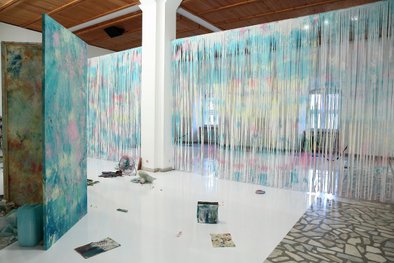
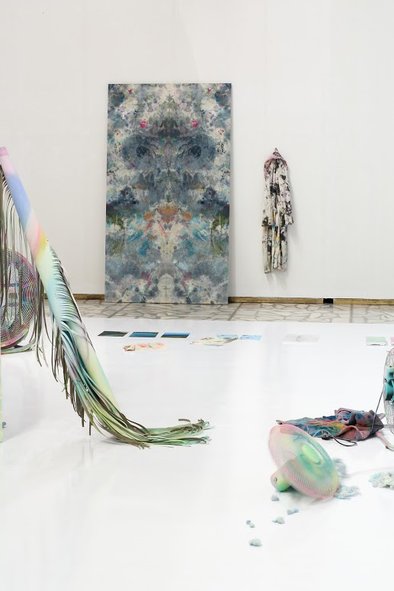
Blue Lagoon
Installation, oil and acrylic on various objects ,white floor
2014
courtesy of Estonian Art Museum
"'Long Table"
Hand painted tiles on concrete table and bench
14350 cm x 1850 cm x 750cm
public art commission Tallinn Technical University Kuressaare College
ship construction.
competence centre’s testing pool and laboratories building yard, Kuressaare,
Estonia 2015/2016
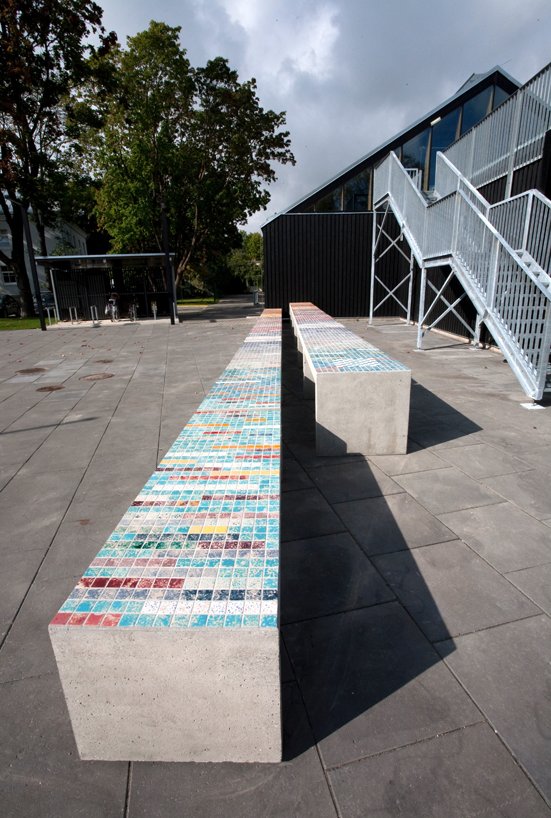
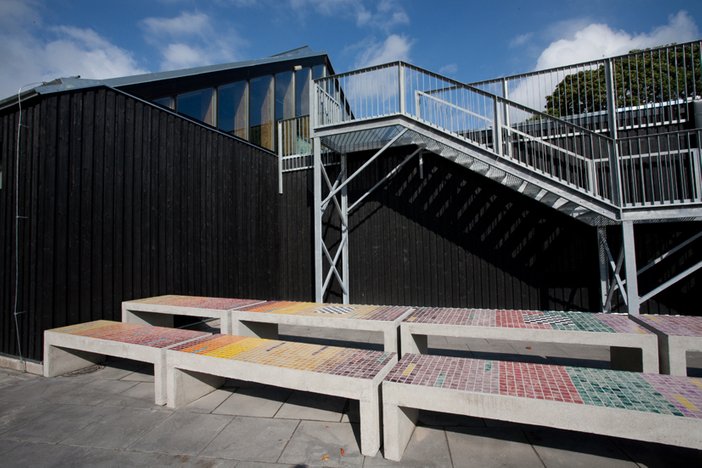
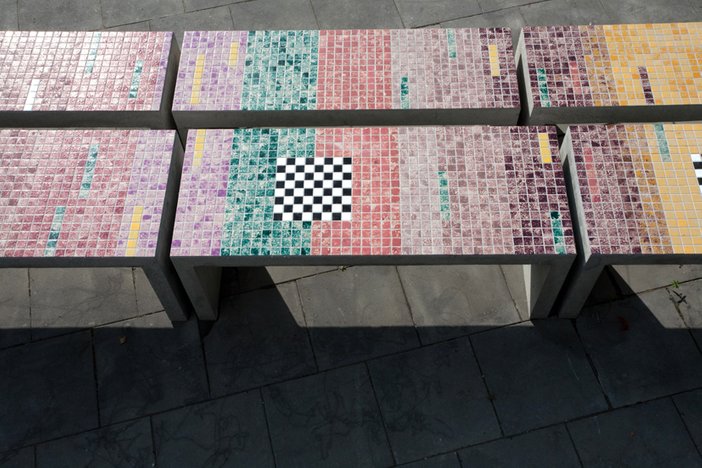
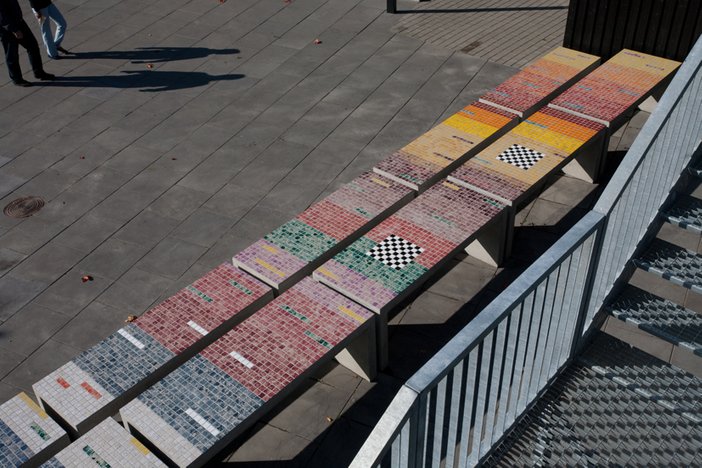
Ghostbiker
Wot No, London Centre for Book Arts (London, UK)
October – 6th November 2016
:http://wotno.org/merika%20estna.html
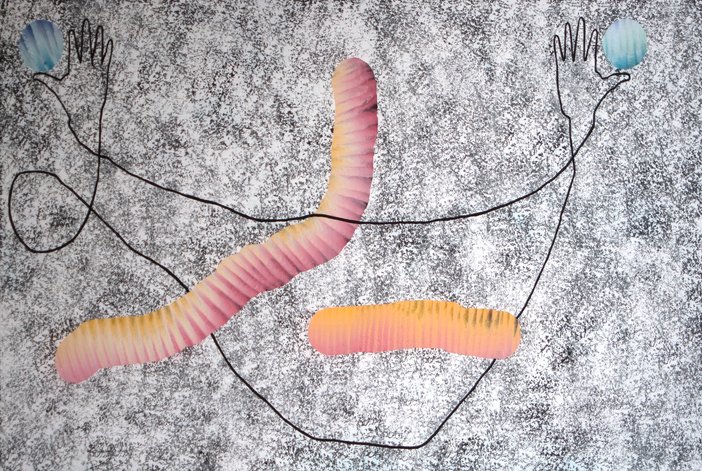
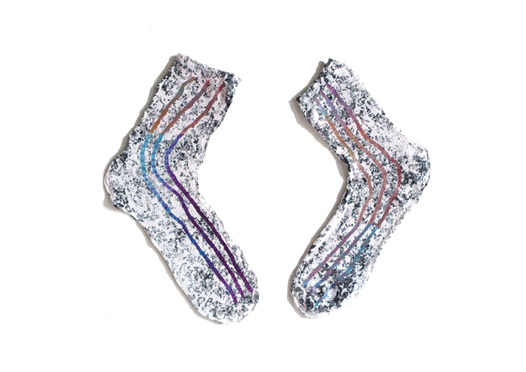
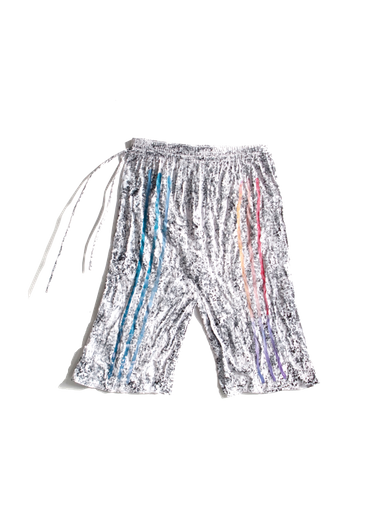
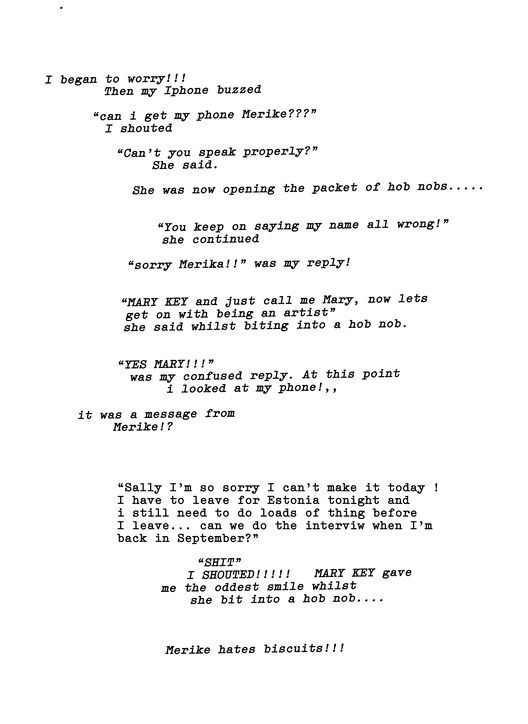

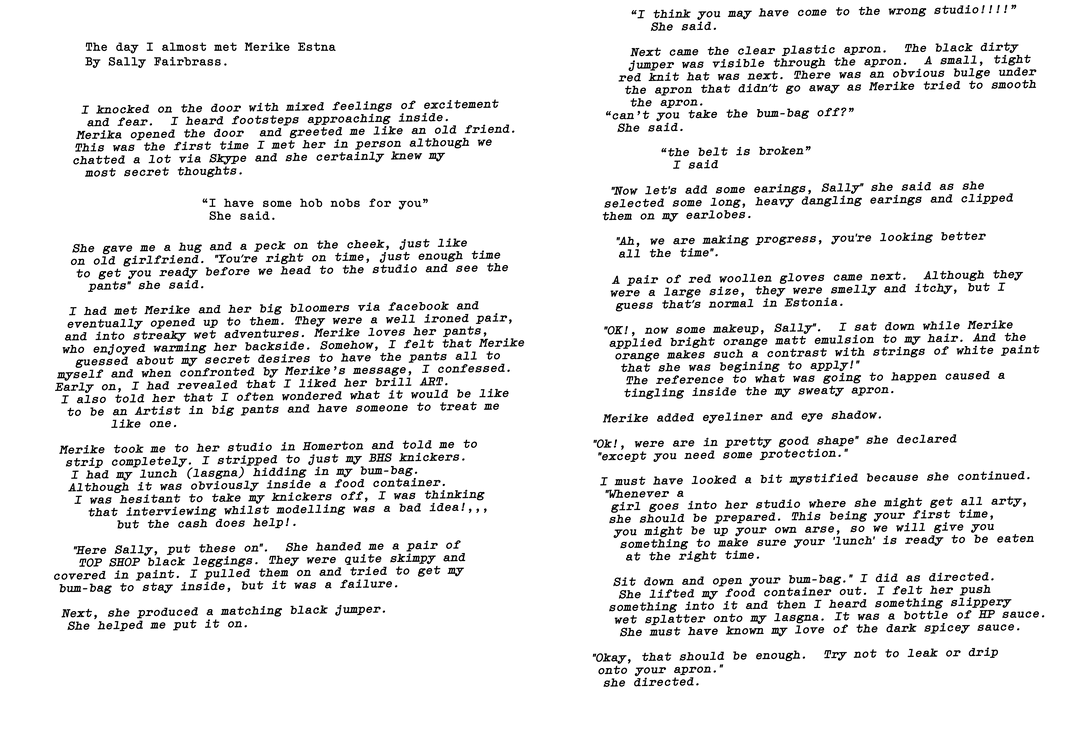
DKUK is pleased to present its first group show (Not) Every Thread Ties Down / Your Split Ends Are Showing, guest curated by Leo Cohen and Lucy Rollins. The exhibition responds to DKUK's hybrid environment with a newly commissioned installation of works exploring visual, semantic, abject and ontological ambiguities of hair and “split ends”. Referencing Andreas Eschbach’s The Carpet Makers (2006), set in a dystopian low-tech primitive world where the main industry is the manufacture of human hair carpets, the show realises a speculative exhibition of artworks in the Emperor’s palace that never truly comes to fruition in Eschbach’s sci-fi novel. Artists include: Zoë Paul, May Hands, Sophie Jung, Merike Estna, Byzantia Harlow
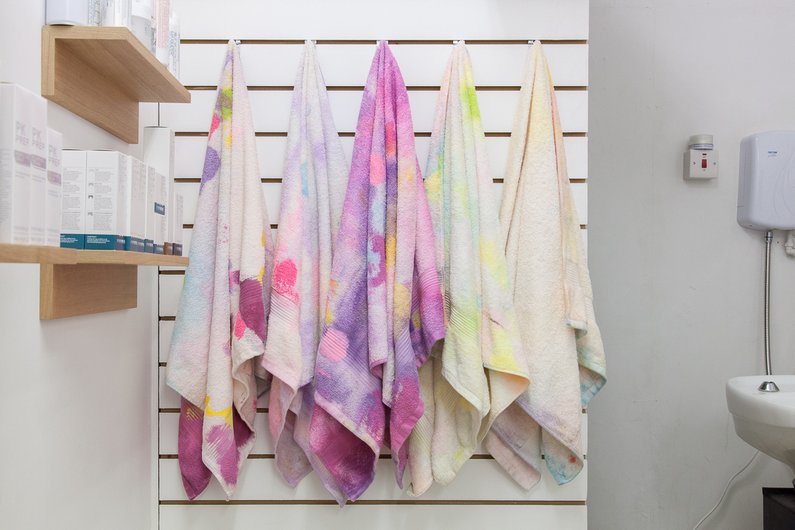
(Not) Every Thread Ties Down / Your Split Ends Are Showing
Curated by Leo Cohen & Lucy Rollins
6/7/16 - 13/8/16
Healthy, Feather, Triple, Tree, Long, Deep, Double Y, Baby, Taper, Thickening, Offshoot, White Spots, Knot, Incomplete Split, Right Angle, Crinkle — “I found the Mother of split ends today”.
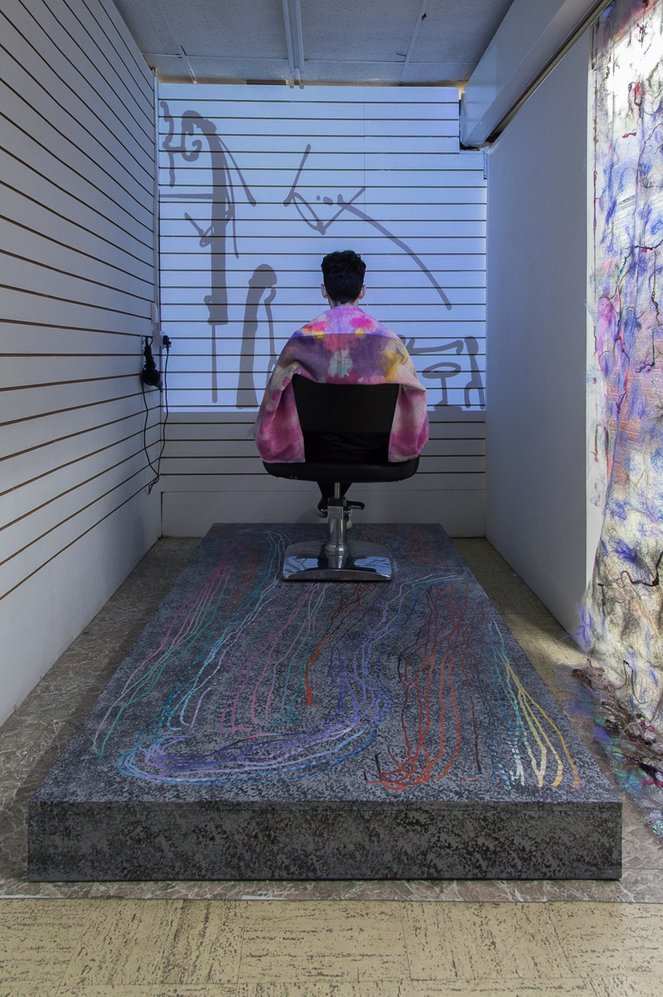
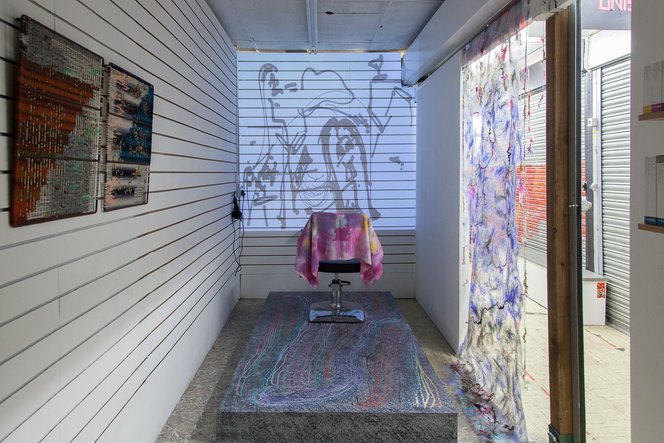
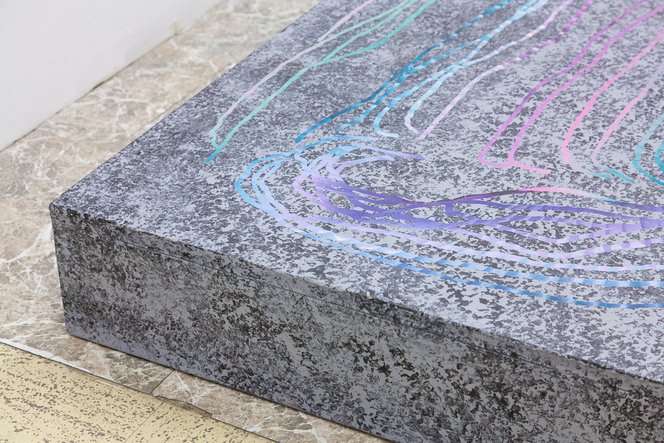

The seed can be initialized randomly
duo with Ana Cardoso, Murias Centeno
(Porto, Portugal 25 Jun 2016 - 24 Sep 2016)
The seed can be
initialized randomly
or
alternatively
it can be chosen
as a function of
the skeleton point
by conceptually
partitioning
the entire
input space
with a grid of lengh o,
and using the id
of the cell
occupied by x
in this grid
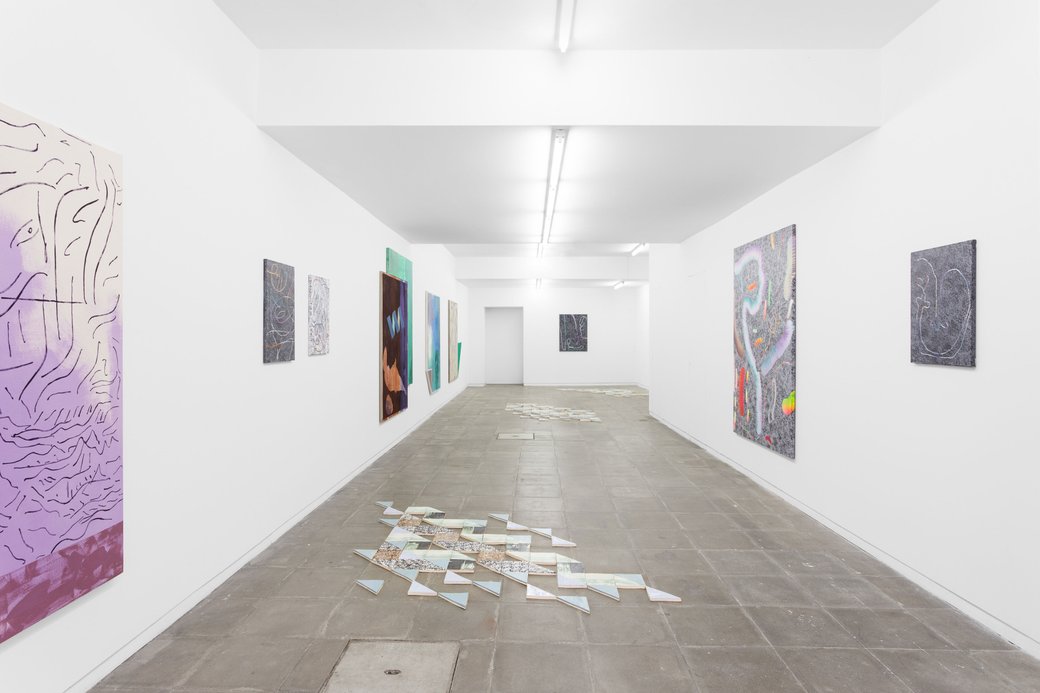
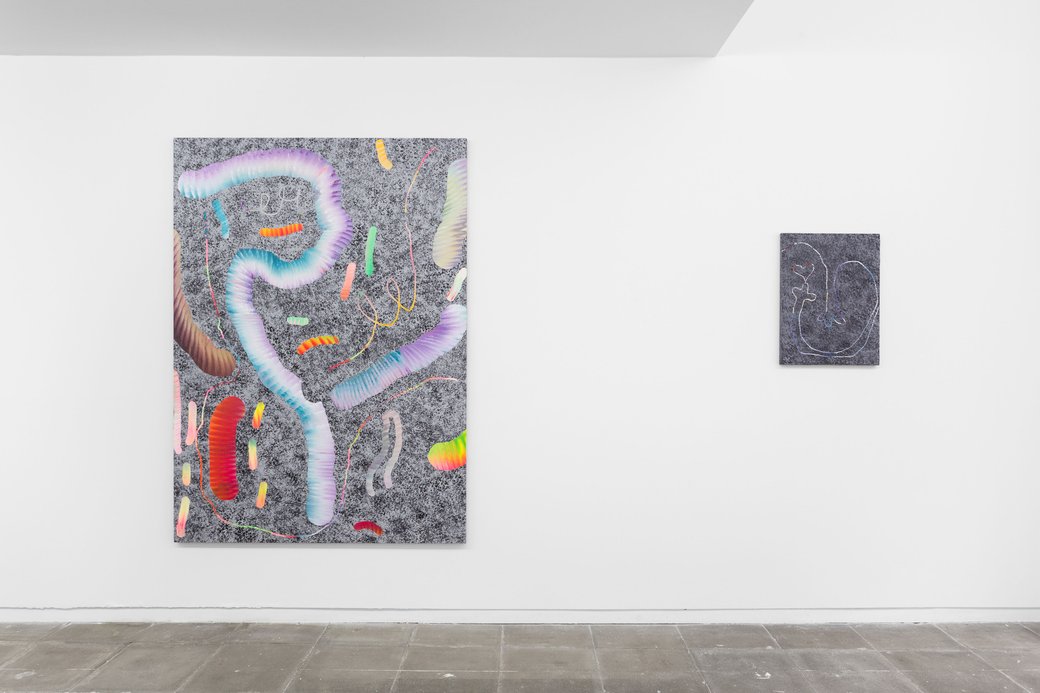
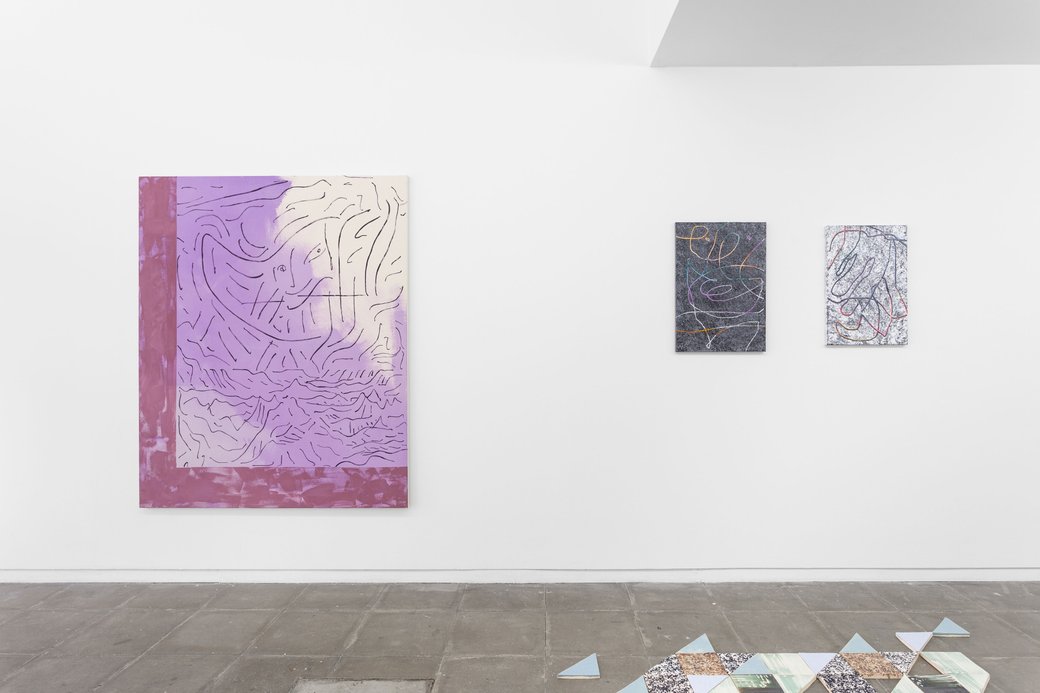

DOMESTICMINDCRAFT
solo
30 January - 14 March 2016
Karen Huber Gallery Mexico City, Mexico
curated by Octavio Avendaño Trujillo
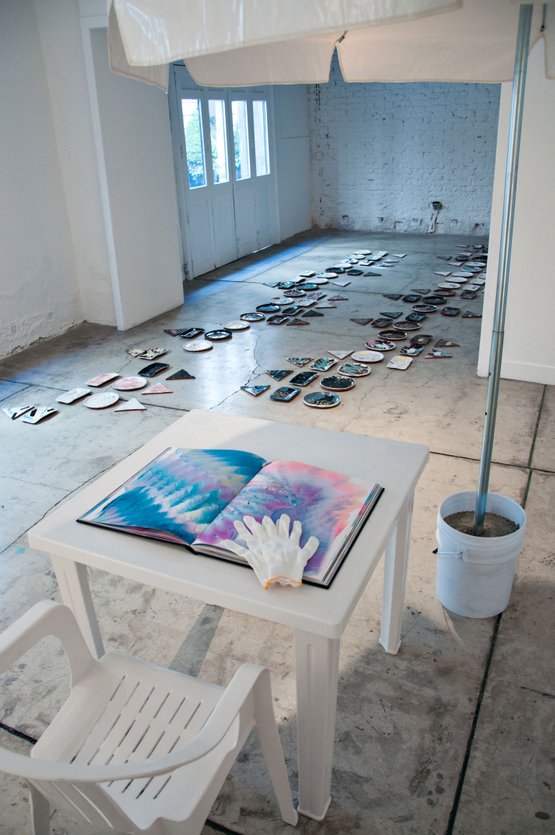
Merike Estna’s pictorial production establishes a series of critical stands before painting as an institution. What are the implications of shifting and activating a painting in natural scenarios that remit to the Romantic School of the 17th century? What happens with the time-history relationship of painting when confronted with its own clichés? What are the political veils that are heightened because of these tensions? Both through Estna's artistic proposal, and through the visitor’s experience, these questions and its possible answers are articulated through the corporality and space of the artist, the pieces and us. A sense of immersion is generated at
diferent scales of dissent before the heteronormative nature of painting and art itself.
Confronted by this, Merike puts at stake the normativity of gender and of the language of painting, provoking a sense of performativity behind the experience. Through what categories do we see and relate to art? Just as Pollock’s Abstract Expressionism instrumentalized the painting by a violentization of the pictorial gesture through the body, Merike Estna ampli es her corporality through a re ned humor that is activated as a critical agent of the masculine.
Hence, the pictorical space for Estna reveals its possibilities as a place of assembly and exchange of subjectivities, presented by the objects that are re-signi ed before each specific cultural context in which
Merike works.
